|
Commander
in Chief British Army of the Rhine; Commander Northern Army Group of NATO at
time of the Cold War, Master Gunner St James Park, KCB |
General
Sir Martin Baker Farndale KCB 6 January 1929 to 10 May 2000
FAR00911
|
Martin Farndale’s coat of arms |
Headlines
of Martin Farndale’s life are in brown.
Dates
are in red.
Hyperlinks
to other pages are in dark
blue.
References
and citations are in turquoise.
Context
and local history are in purple.
Geographical context is in green.
The text in italics below is in Martin’s own words,
extracted from a retrospective journal.
There is a separate page about the life of Martin’s wife,
Margaret Anne (“Anne”) Farndale (nee Buckingham) (BUC00002).
This page should be read in conjunction with chapters
regarding:
·
Video
and audio recordings of Martin Farndale transferred from original cine and
tape reels, cassette and video.
·
The Royal
Military Academy Sandhurst Intake 1A 1946 to 1947.
·
Martin Farndale and First
Regiment Royal Horse Artillery 1950 to 1971 and thereafter and a page
of further material.
·
Commander 7th
Armoured Brigade, The Desert Rats, 1973 to 1975.
·
Commander Second
Armoured Division 1980 to 1983.
·
Commander 1st
(British) Corps 1983 to 1985.
·
Commander British
Army on the Rhine and Northern Army Group 1985 to 1987.
·
Colonel Commandant the
Army Air Corps from 1979.
·
Master
Gunner St James’ Park, 1988 to 1996.
·
Martin and Anne’s Wedding
in 1955.
·
Anne Farndale’s journal
of travels from 1946.
·
A record of the
Journey from Malaya to the UK overland in 1962.
Trochu,
Alberta, Canada
1929
Martin Baker Farndale was born in Trochu, Alberta, Canada, the eldest
son of Alfred and Margaret Louise (nee Baker) Farndale (FAR00683) on 6
January 1929. The birth was registered at Trochu
on 1 March 1929.



I was born eldest son to Alfred and Margaret Louise Farndale
(nee Baker) on 6 January 1929 at Trochu, Alberta, Canada. Trochu is about 100
miles north north east of Calgary and 20 miles south
south east of Red Deer. Alfred and Margaret (always known as Peggy) were
married at Bedale Church, Yorkshire on 16 March 1928 and had moved directly to
Canada where Alfred’s older brothers, Martin and George were already living
together with an older sister, Kate. Two other brothers had also been in Canada
– James who had moved to USA in 1913 and William who died of influenza in
Winnipeg in 1919. Alfred was soon joined by his sister Grace, who later married
Howard Holmes.
Martin’s early life
1929 to 1935
Martin Baker Farndale lived in Huxley, Alberta, Canada until
1935.
Alfred rented a section and a half near Huxley some 10 miles
north of Trochu and built a house there. The farm was almost entirely devoted
to wheat but with some cattle. I grew up at the farm and my first memories are
of playing on the prairie and around the slews (a kind of duck pond) near the
farm. I remember all the horses used for farm work, the box waggons with racks,
threshing in the fields and the hot summers. The winters were cold - well below
zero, and I remember the horse drawn sleighs and the bright sun on the snow. I
remember the village of Huxley, the annual sports day, the Legion parade and
buying sweets at Miss Hibbs’ store. I remember visits to the neighbours, the
Hoggs, the Saggers, the Morris’, the Wagstaffs, the Millers and I remember the
postman, Mr Hibbs whistling in his buggy as he came up the road to what is
still today called Farndale’s corner. But above all I remember the family.
Uncle Martin and Aunt Ruth lived near Trochu and he
spoiled me a lot. Uncle George was a bachelor, remote and living alone near
Three Hills. Aunt Kate was strict and austere, but kind and she lived between
Trochu and Three Hills with her husband Bill Kinsey and their children George, Alfred and Dorothy. I remember evening parties and sitting
waiting while the grown ups played bridge. I remember being well looked after
by our nannie, Gladys Grist who later married Aubrey, the son of our nearest
neighbour, Ralph Hogg.





The Farndale house near Huxley Martin
returning to the house in the 1970s
There was a visit by mother’s sister, Aunt Hilda from England and we all (by this time my sister Marianne
Catherine Farndale and brother Alfred Geoffrey Farndale had been born on 30
October 1930 and 10 April 1932 respectively) went to Banff and on through the
Rockies by train to Vancouver and Victoria Island where we looked over the new
liner, the Empress of Japan.


On another occasion we stayed at the Palliser Hotel in
Calgary and went up in a lift for the first time and we visited the Calgary
Stampede.
I was playing with Meccano one afternoon at the farm when a
bunch of Indians rode right up to the door in search of work. I also remember
Uncle Jim and Aunt Edna with their family Hazel Jae, Jimmy, Mary, Doris and Gordon, visiting from USA. I can remember their
arrival in a large open car with luggage tied all around it.


Sergeant Hammond of the Royal North West
Mounted Police often visited the farm.



Martin, aged 1 year and 9 months at Huxley in September
1930 Martin and Anne, Vancouver
1931 Martin,
Geoff and Anne at the farm at Huxley in 1934
One event I can remember clearly was when my father promised
to take me the 5 miles or so to the other half section – the Wickizer Place –
to see the horses. Towards evening I was playing around the threshing set at
the farm when I saw a Chevrolet car like the one my father owned drive past the
red gate at the entrance to the farm and was convinced that I had been left
behind. I therefore set off to walk. I was about 6 years old
and the corn was high and it was getting dark. There was consternation when I could
not be found later on, for once into the corn I would
be very difficult to find. Search parties were called out from neighbours and
from Huxley but apparently I had got into a ditch
beside the road and could not be seen. However the
ditch took me to Huxley and though I can remember nothing about my 3 mile walk,
I do remember being picked up by two men who worked in the Huxley garage and
being taken home to a mixture of relief and scolding.



I remember my sister Anne falling down the cellar steps,
and, on another occasion, while visiting Aunt Grace and Uncle Howard, throwing
his best spanner down his well. I also remember learning to ride our horse,
Chubb and I remember our Colley dog, Scot, who slept beside my bed.








1935
But things were not well on the farm. Prices were bad in the
slump years of the early 30s and the weather was unkind so that my father,
along with many others, soon lost all his savings, and in 1935, he decided to
return to England. I remember well the excitement of the farm sale by our white
house with a black roof, on the hill overlooking Huxley. It was early April and it was cold with snow still on the ground. We
spent our last few days in Alberta with Aunt Grace and Uncle Howard at their
Ranch near Huxley and finally caught the train at Huxley for Edmonton on 9
April 1935.

At Edmonton we changed onto a CNR train for the four day journey to Montreal. I remember my brother Geoffrey
having his third birthday on the train and having a cake. I remember the train,
and the porter turning the seats and the roof rack into beds at night and the
small carriage at the end of each carriage for cooking. I remember the
observation car and passing endless forests and lakes as we crossed Canada. We
changed trains at Montreal to a train entirely staffed by French speakers for
the two day trip to Halifax where I can remember my
father saying, as we boarded the ship, that we had now come half way!
The voyage across the Atlantic was on the Duchess of
Bedford. We sailed on about 17 April 1935. The weather was cold and foggy and we saw icebergs through the fog. Later across the
Atlantic it was pretty rough and I was sea sick until
I was taken on a walk around the deck by my father. I can recall the meals and
the huge excitement of the voyage. I saw the north of Ireland and we sailed
into Liverpool on about 23 April 1935. There at the quayside we were met by
mother’s brother, Geoffrey Baker and her sister, Hilda Baker. We were taken to
stay with cousins at Conway in North Wales while my father went off to
Yorkshire to sort out our future back in England.
Northallerton
and Thornton le Moor
Then
due to the slump and drought the family moved first to Middleton-one-Row in
Durham, England. Then in 1936 to Sycamore Lodge, Thornton-le-Moor, Yorkshire.
He went to Wensley House private School
in Northallerton and then to Northallerton Grammar School. His family
moved to 117 Crosby Road, Northallerton
in 1940 and then to Gale Bank Farm, Wensley
in Wensleydale in 1944. He then went to
Yorebridge Grammar School until 1946 until he joined the Indian Army at
Caterham on 3rd September 1946.
I remember our stay in Conway.
King George V’s silver jubillee was in June 1935 and there were parades and
illuminations at Conway Castle. We visited Snowden and Betsy Coed and later
drove to “The Upwoods” in Derbyshire near Utoxeter where Uncle Geoff and Aunt
Hilda lived.
Manwhile my father was
negotiating the purchase of a farm at Middleton-One-Row near Darlington ad we
moved north to stay with my father’s sister, Dorothy ad her husband Alfred Ross
who lived at Gree Farm, Skelton Green, Skelton in Cleveland. Eventually in
about Septemer 1935, we moved to the 100 acre farm at Middeleton-One-Row on the
Rver Tees and just inside County Durham. But it was ot a success and my father
was already looking for something better. I do’t remember too much about this
period except visiting new relations. In particular my sister Ane and I wenty
to stay at Tancred Grange at Scorton near Ricond to stay with yet another of my
father’s sisters. Lynn, whose husband George Baker had died many year befoe,
but living there were their children, Margaret, William, John, George and
Dorothy. I particularly remember their gooseberry pies! Another fist visit was
to my father’s eldest brother John who lived with his wife Elsie at Tidkinhow
Farm near Guisbrorough where all the Farnale family had been born. I have
memories of my uncle John clipping sheep near the house.
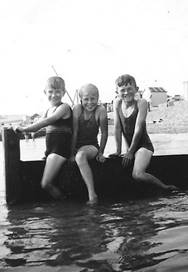
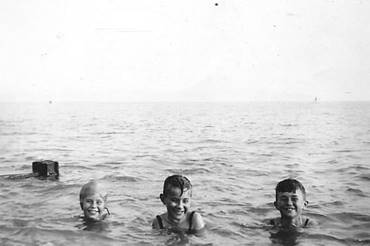
1936
Then in Spring of 1936
we moved again to Sycamore Lodge Farm, Thornton-Le-Moor, near Northallerton
which was a much better and slightly bigger farm, but still not really big
eough for my father’s plans. I was seven and my sister Anne was six and we had
ot yet been to school. So mother fixed us up at a small private school called
Wensley House School in South parade, Northallerton which was run by an old
fried of hers, Mrs Harriet Lord. I have a lot lof memories about Thornton
-Le-Moor and Wensley House school and holidays by the sea with Aunt Dorothy at
Skelton or Aunt Hilda in Derbyshire at the “Upwoods”. I thoroughly enjoyed
working with my father about the farm. Most of the work was done by horses and
at threshing time great staem engines arrived with great gags of men who worked
through the threshing days. Huge meals were cooked by my mother for up to
twenty men at a time. Again we had a Nanny, Betty, who married the son of the
farmer oppositie (history repeating itself!), but he was tragcaly electrocuted
by his new electric milking machine only a year or so later.
Every day Anne and I,
and later Geoffrey as well, were driven into Northallerton, which was five
miles away, to school and we were collected in the evening. School was a very
new adventure and ot easy going for me. Mrs Lord was a hard but far task master,
insisting on high standards. Much was leart by heart – poems, hymns and tables.
Mr Lordtaught history ad geography and these quickly became my favourite
subjects. On Friday aftrernoons the school walked in a long crocodle to the
village of Romanby, there to sit and watch lantern slides given by a Mr and Mrs
Linton about their travels to the Holy Land and Egypt. These were wonderful,
hazy black and a browny colour and white, but they opened up the idea of travel
and excitement. They also taught us a great deal and left a deep impression on
me. It was at Wensley House school that I made my first friends. Richard
Sawfell was the son of the county surveyor whose mother kew my mother before
they were both married. David Ramsden was the son of a farmer near Northallerton.
Jack Errington came with his mother during the school holidays to stay with his
Grandmother in Thornton-Le-Moor.
1938
About this time I
became aare of the world situation and listening to the BBC radio news became a
feature. There were press pictures of a man called Adolf Hitler and another
called Mussolini. My father talked about his army days and our games in the
woods were always as soldiers fighting the Germans. Once, it must have been in
about 1938, I remember seeing a colour film about Rogers Rangers in Caada and
for months afterwards we were Roger Rangers in all our games. About this time I
was given a bicycle. We used to cycle everywhere with Betty and it was all
exiting.
On Sundays we went to
the village Sunday School and on Saturdays we each had 6d (sixpece) and spent
it at the village shop seeing how many differet items we could get. One stick
of licquorise and a small paper sachet of sherbert were about 1/4d each, a small
packet of sugar cigarettes a penny and a bar of chocolate 2d. I was pretty
bossy at that time and I had the advantrages of ‘supervising’ the expenditure
of all our money, which together was 1/6d. I collected tin soldiers at 1d or 2d
each. This normally meant going to Northallerton or exceptionally to Woolworths
at Darlington. I also collected Meccano and Hornby trains, but had to rely on
Father Christmas for these more exensve items.
My parents both worked
very hard and times were not easy. My mother looked after us wonderfully well
and set very high standards. She taught us all how to behave, how to talk, to
dress and conduct ourselves in company. There were quarrels, which I remember
worried me, but I realised they were never very serious.
In 1937, on 8 October,
my sister Margaret Susan was born. The idea was that the three of us should go
and stay with Aunt Dorothy for a few days during the confinement, which was of
course at home. My father took us half was and at the Tontine Hotel near Stokesley
we met my aunt who would take us on. However Geoffrey, who was five at the
time, screamed and yelled and refused to go and had to be taken back home. We
were all very excited about the new baby and took it in turns to help. Life was
suddenly very busy.

Family photograph, Sycamore Lodge, Thornton-le-moor, 1938
Martin
Farndale, Geoffrey Farndale, Peggy Farndale, Anne Farndale
Margot
Farndale
1939
By 1939 Margot (as she
was always called) became our casualty in games and was regularly carried about
in a stretcher. It can’t have been very safe. Over Christmas, 1938 I think, I
was given an air rifle. This was a truly prize possession and gave me a huge
advantage over everyone. One evening, Jack Errington and myself decided to
ambush cars as they came along the road into the village. We were certainly not
firing pellets, but the village Bobby did not know that and he cycled up to us
and made a great point of entering our names into a book and saying how
dangerous air rifles were and that he would speak to my father. I was
terrified, but nothing ever happened. I’m sure that he never did speak to my
father, but he taught me a lesson early in my life which I’ve never forgotten,
about the dangers of weapons.
About this time there was much going on that I didn’t understand. My
mother would come and sit with me as I went to sleep at night and these moments
became highlights of those days. I adored her, she seemed to understand
everything and she never failed to set my mind at rest whatever my problems. I
owe her a great deal indeed. She ensured that we grew up with balance and
understanding of other people. My father, who I worshipped, represented all that was
strong, good and upright in life. He was direct, outspoken and eliable. I
always felt nothing could happen to us if he was there. We were unbelievably
lucky with our parents. Almost without knowing it they gave us all an ideal
upbringing, treating us all the same, insisting on standards, respect for them,
and for the law, yet with love and understading which gave us great confidence.
By 1938 I realised that
I was to go to Northallerton Grammar School if I could pass the entrance exam.
It was clear that I had a chance, but that my maths was weak. I remember that
three times a week a retired school mater, Mr Archer, came in to teach me
maths. I didn’t enjoy it but it did help. Anyway in 1939 I passed the exam,
though ot with the scholarship which would have helped my parents so much. I
was to start in September 1940. By 1939 it was arranged that Anne and I should
go to school by train. This meant cycling to Thornton-Le-Moor station and then
walking from Northallerton station to the school in Smith Parade.
I remember pre war
Christmases both in Canada and Yorkshire. It all started at Haloween on 30
October, which was Anne’s birthday. We hollowed out turnips and cut faces in
them, putting candles inside and suspended them from sticks and walked through
the village after dark making howling noises. Then came Guy Fawkes day on 5
November with its bonfire and guy, baked potatoes and a few fireworks. Next was
writing letters to Father Christmas, a major event, which was supervised by
Mother. They had to be just right and not asking for too much. School broke up
on about 15 or 16 December and soon we were out carol singining. The exitement
was almost unbreable. On Christmas Eve we left a glass of sherry, a biscuit and
a florin on the kitchen table fo Santa Claus, which had always been consumed
next day. Somehow Santa Claus’ crumbs on the plate on Christmas morning were
magic! I remember the fire in the bedroom on Christmas Eve and its flickering
flames. It all seemed very strange, but we never questioned it. I was eight
when I discovered the truth and was bitterly disappointed, but my mother told
me not to worry as there was no reason for it to stop. Christmas 1939 produced
a clockwork model of the Flying Scotsman, which was a dream come true.
I remember at this time
realising that war might happen. We were all on holiday at Lymington in
Hampshire, staying with Great Aunt Catherine playing with trains in an upstairs
bedroom with Jack Errington when on Sunday 3rd September 1939 my
mother called us down at 11 o’clock to listen to the radio. I can clearly
remember hearing the Prime Minister, Mr Neville Chamberlain, saying “… we are
therefore at war with Germany”. Things then happened very quickly. Gas masks
arrived and we stuck paper strips on our windows to prevent them shattering.
Evacuees arrived from the big cities. Our farm was used as an assembly point
for them and I was shocked at their poor dress and how without shame they ‘made
water’ against our house. They had never seen a cow or horse and they had bugs
in their hair. They didn’t stay long. They could not take the country and soon
they all went back home.
As the eldest, I had a
few privileges and one was to be allowed back downstairs at 7.30pm to listen to
Arthur Askey and Stinker Murdock in Bandwaggon on the radio and once to go to
the cinema in Tirsk in the eveing to see “Enid Bob” with my parents. We all
always went to bed at 7pm until we were about ten. Non nonsense, no arguments.
However we were always tired and were asleep in minutes.
Our birthdays were
always made into great days, but without ostentation. We all had to save up to
buy each other presents, not much, but enough to make the point. We used to get
together and make or buy something for our parents and watch the huge pleasure
which they always showed when we woke them up. Times were never easy in those
days. We never had much but we learned early how to use it, save it, and how to
think of others.
At this time my father
felt that we must move and that he must get a bigger farm. Rightly or wrongly
in 1940, he sold Sycamore Lodge ad we moved to 117 Crosby Road, Northallerton.
My father became a thrashing and ploughing contractor until he could get another
farm. To his dismay this period turned out to be some three years.
I started at
Northallerton Grammar School in September. I was sorry to leave Wensley House,
which had given me a wide background in life. The Grammar School was big and
frightening, particularly the head master, Mr H J Palmer. Competition entered
my life and I was pushed to keep up. I managed well in arts, but struggled with
French, maths and French.
It was while at school
that I joined the Boy Scouts and was very proud of my uniform. I took it all
very seriously as a patrol leader of the Woodpeckers. I became keen on woodwork
and model making, using tools and odd scraps of wood to make ships and aeroplanes.
Idetifying aircraft was an absolute requirement and most of us could identify
both British and German planes by sound alone. My scouting led me to do duties
on the air raid warning communications in the Town Hall when I was thirteen.
This seemed most important particularly when we got warning of enemy aircraft
approaching. About this time I joined D Company of the Northallerton Army Cadet
Force battalion, which involved drill nights twice a week at the new
Allertonshire Secondary School. There were Saturday morning parades and
exercises. We were attached to the Green Howards and wore their cap badge. I
was proud of my battledress and Green Howards uniform and my first guard duty
was at Gallowgate Camp, Richmond, ouside our tented camp.
The 1939 Register for Sycamore Lodge, Thirsk listed
Alfred Farndale, born 5 July 1897, farmer (mixed); Margaret Louisa Farndale,
born 24 February 1901; Martin, Ann, Geoff and Margot records not yet open;
Lerna E Gerrard (later married Hutchinson), single, born 6 February 1918, paid
domestic duties.
1942
By about 1942 I got a
Saturday job as an errand boy working for the local grocer’s shop and I often
helped to serve in the shop too. This gave me 2/6d for a morning’s work and
together with my now 1/- pocket money on a Saturday, this gave me untold riches.
We went off on visits much less now, but somehow we still got away on holidays
to Skelton and occasionally to the Upwoods. On many occasions at Skelton we
could hear the bombing and the anti aircraft guns on Teeside. This happened in
Northallerton too. One night a stick of bombs fell right across the town with a
terrific crash as we huddled under the stairs. My father made a dug out in the
garden, but it filled with water and I never remember us using it. One
afternoon, with Aunt Lynn with us for tea, a German bomber flew overhead with
two spitfires attacking it, machine guns blazing. On another occasion, while
playing in a field on David Ramsden’s father’s farm, a Heinkel bomber came low
overhead and we stood mesmerised looking straight at the German pilot, but
nothing happened. My father was a special constable and went out nightly
helping the police.
Geoff had a lazy eye at
that time and wore a black patch on his good eye for a year or two and glasses.
He also got scarlet fever but recovered in good shape. Generally we were all
very healthy. Once when we were all out cycling towards Osmotherly Geoff fell
off his bike when his brakes failed, coming down a hill, and he was knocked out
losing part of both his front teeth I remember my shock as I found his
unconscious body by the road. Together we somehow got him to a farm who drove
us back home. It was an awful shock, but again it was mother who made it all
come right. I blamed myself, but she explained that it was an accident, but
warned us to be more careful in future.
Gale
Bank Farm, Wensley
Towards the end of 1942, I came home from school one day to be told by
mother that it looked as if we had got a farm near Wensley in Wensleydale. I had never been there,
but I knew some children at school who came from up there. It had always seemed
a strange a remote land to me. However I was to cycle out to quickly give the
message to my father as he was wanted for an interview. Apparently the existing
farmer was not up to the standard demanded in war time by the War Agricutural
Committee and he was being turned off the farm. My father was to be interviewed
by the “War Ag” and by the Bolton estate on which the farm lay. I remember to
this day the excitement he showed saying in his quiet way, “that’s splendid
news”. It was indeed the best farm he had bid for and the one he wanted most,
some 450 acres between Wensley and Middleton, called Gale Bank Farm. He knew it well and
had already done some work on it. A few days later we heard that he had got it,
which was indeed wonderful news. It meat a lot of changes. Anne and I were both
at Northallerton Grammar School aged 13 and 12, Geoff was at Wensley House
School aged ten, and Margot at home but about to start school.
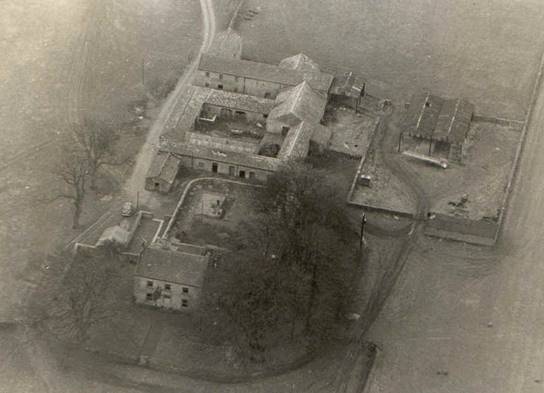
Gale Bank Farm
1943
We moved to Gale Bank
on 28 January 1943. I remember it all very well. The furniture van came and
everything was packed up. The rest of us went in our heavily overloaded
Standard 12. I remember it over heating just outside Bedale and my father going
into a farm and helping himself to a bucket of water! I remember our arrival
well, the house, and the buildings were quite empty and we children raced
throughout the empty house. There were strange smells everywhere, particularly
that of smoked bacon, which our predecessors had done for years. We raced
through all the farm buildings which were big and extensive compared to
anything we had known before. It must have been cold in January and apart from
a fire in the drawing room and kitchen in daytime only there was o heat. But I
don’t remember it being cold. With great excitement we all chose our bedrooms
and then the furniture van arrived and we all helped move our things into the
house. The beds were made – the same ones we had got out of that morning in
Crosby Road, and we were ready for bed in our new house. Little did we know
what a major step in our lives this day was to be for us all. Gale Bank was to
become our home, and a firm base for us all, for many years to come. Geoff and
Margot started at Wensley school. Anne and I started at Yorebridge Grammar
School straight away. This meant a three mile walk or cycle across the fields
and roads to Wensley station, a 15 mile train journey, and then s short walk to
the school, then a return in the evening. It meant an early rise, leaving the
house in the dark at 7.15am and getting home about 5.15pm.
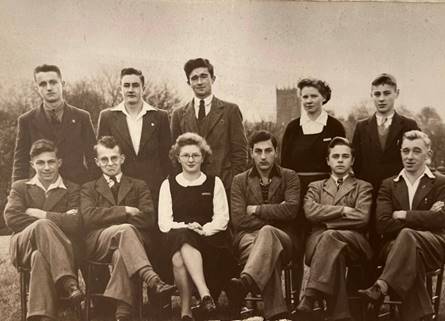
Yorebridge Grammar
School (Martin Farndale centre rear row)
Summary of Martin Farndale’s Military Service
Martin Baker Farndale joined the Indian Army on 3
September 1946, transferred to the British Army in 1947 and went to the Royal
Military Academy Sandhurst where he was commissioned into the Royal Artillery.
Served in Egypt, Germany, Malaya, South Arabia, Ireland. He commanded The
Chestnut Troop, 1st Regiment RHA, 7th Armoured Brigade, 2nd Armoured Division,
1st British Corps and Northern Army Group. He became Commander-in-Chief British
Army of the Rhine and Master Gunner St James’s
Park. Awarded General Service Medal with clasps for Malaya, South Arabia and Northern Ireland. Awarded Silver Jubilee Medal in
1977, Commander of the Order of the Bath in 1980 and Knight Commander of
the Order of the Bath in 1983. Awarded 125th Anniversary of Canada Medal for
services to Canada. Hon Degree Literature at Greenwich University.
Martin’s early Military service 1946 to 1960
1946
Martin joined the Indian Army on 3 September 1946.
Caterham
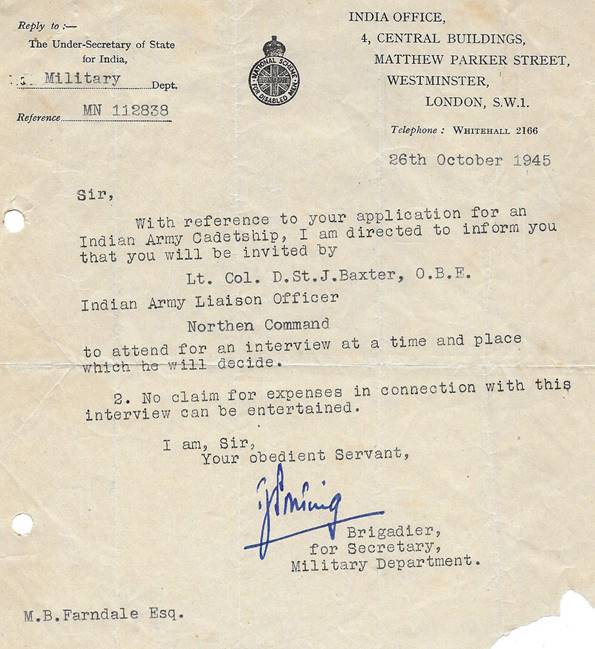
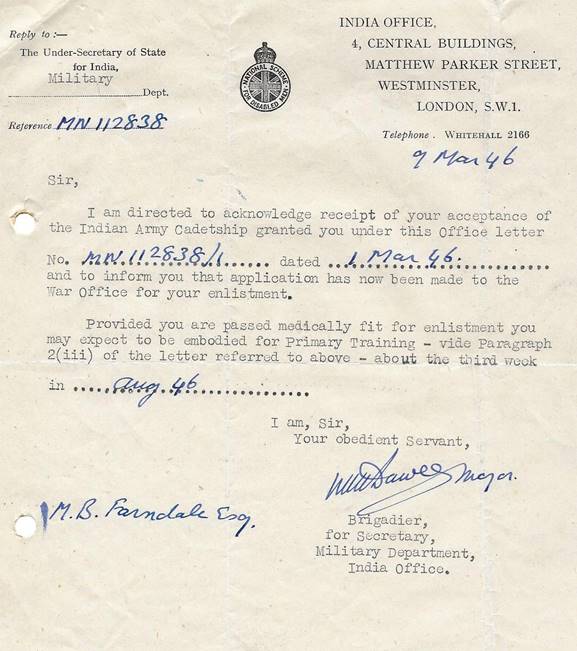
He was ordered to report to the Guards depot at Caterham:
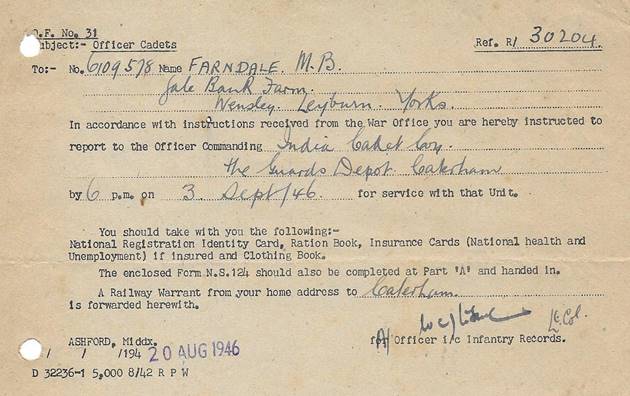
Life at the Guards depot:
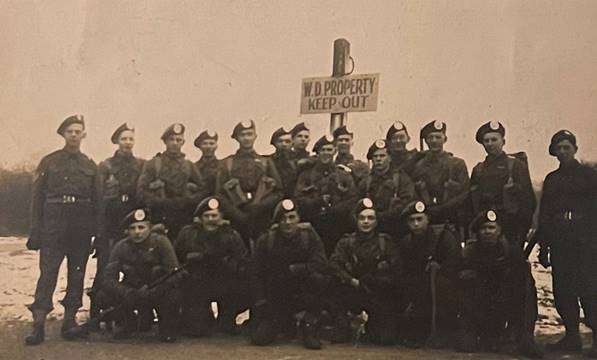
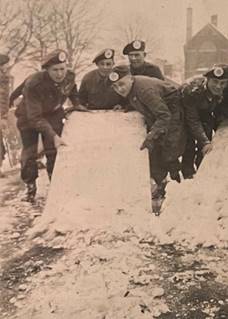
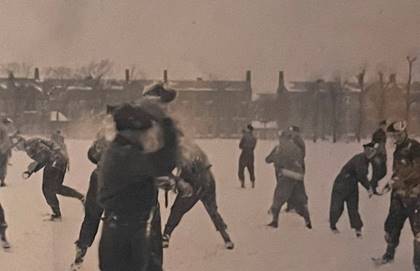
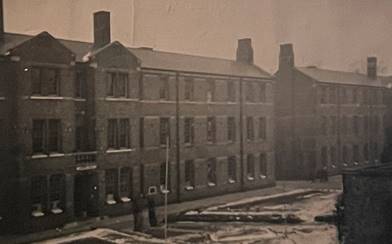
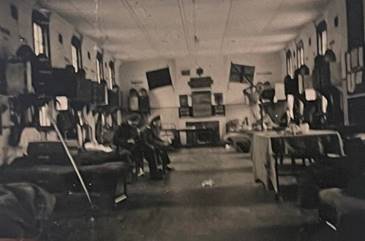
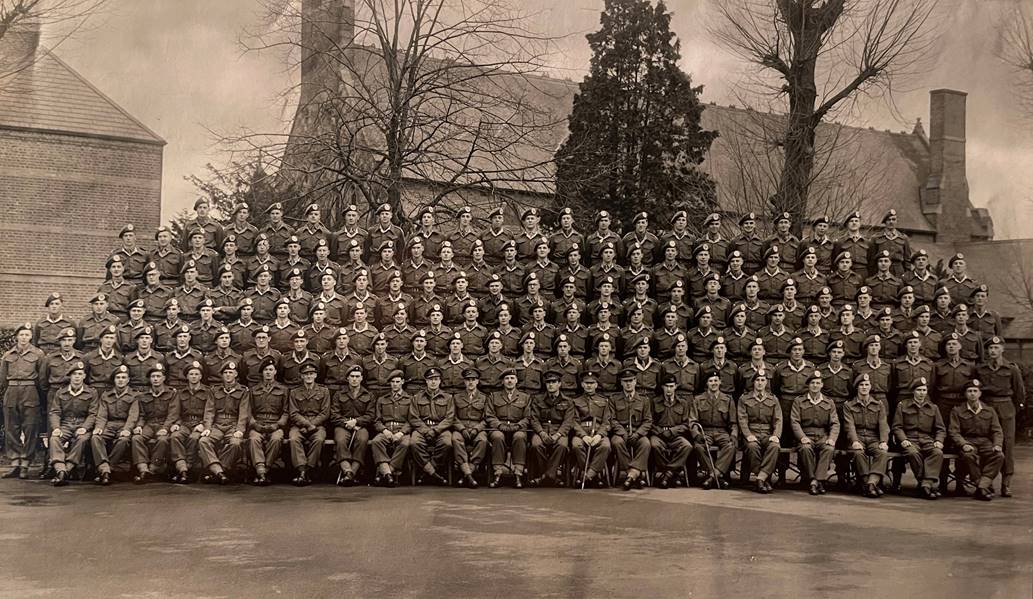
1947
He transferred to the British Army in 1947, after Indian
independence.
Royal
Military Academy Sandhurst
He went to the Royal Military Academy Sandhurst where he was
in his company's boxing and motor-cycle team. He won the Brian Philpotts
Memorial Prize for Military History. He was Intake 1A, Dettingen Company and
passed out on 20 October 1948.
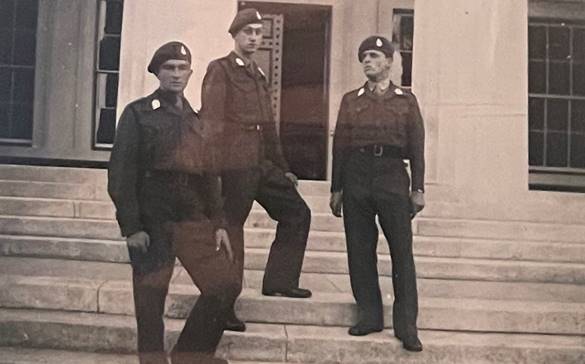
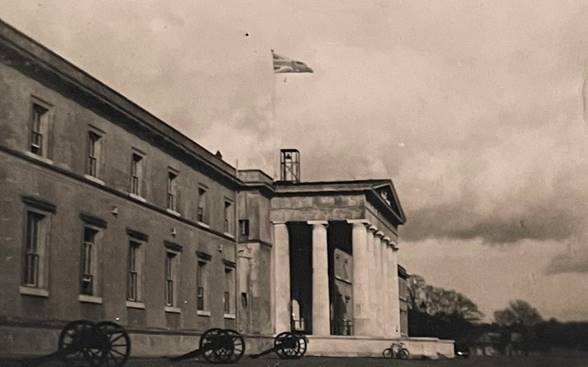
There is a separate page about Martin
Farndale’s time at the Royal Military Academy Sandhurst which is also a record
of the first days of Sandhurst.
1948
Larkhill
He was commissioned into the Royal Artillery. He attended
the RA Young Officers' Course.
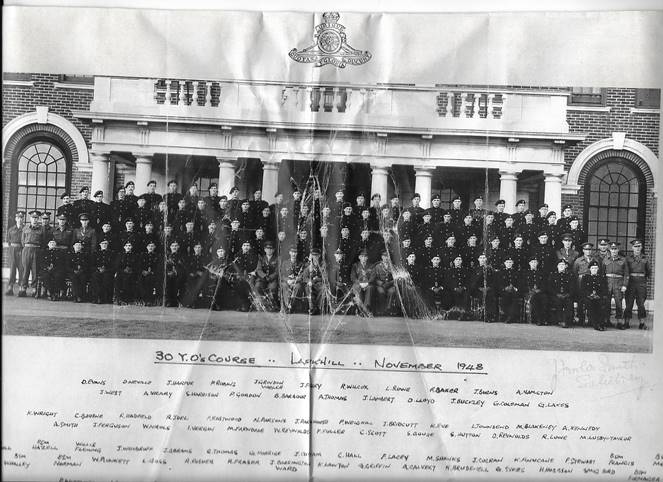
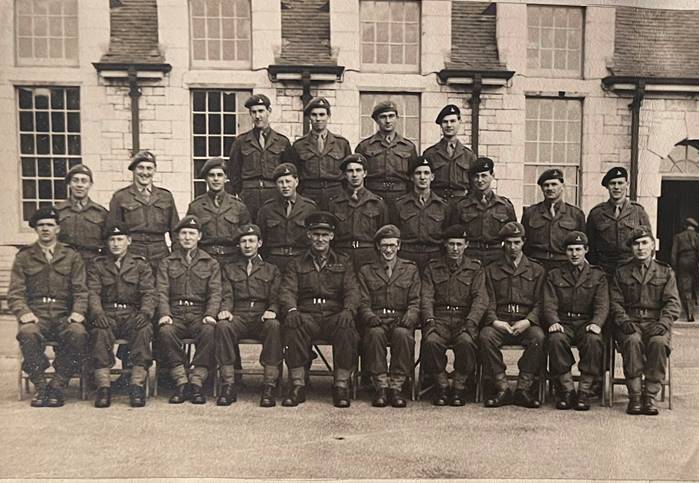
Young Officers’
Course, Larkhill, November 1948
Young Officers Coastal Artillery Gunnery Couse, November 1948, Plymouth,
Second Lieutenant Farndale third in the back row
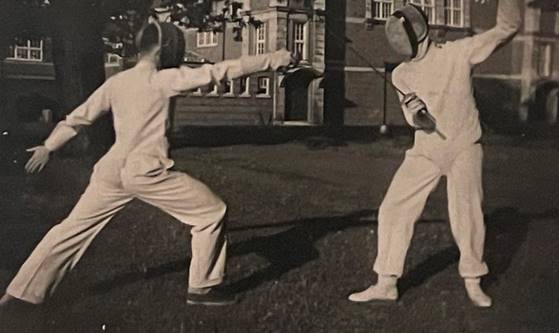
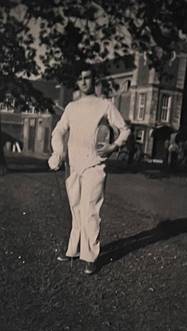
Fencing on the Young Officers’ Course
1949
Egypt
Martin Farndale started his military career in 80th Light
Anti-aircraft Regiment in the Suez Canal Zone. In January 1949, he sailed by
Troop Ship to Egypt with his great friends, John Ansell
and Bill Nicholas.
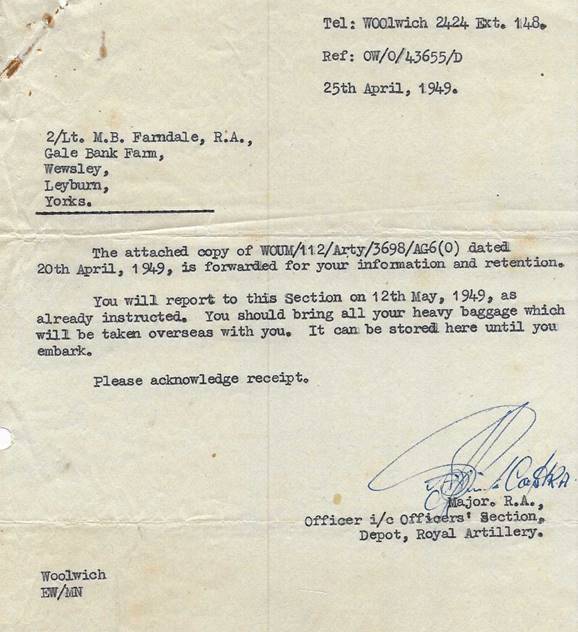
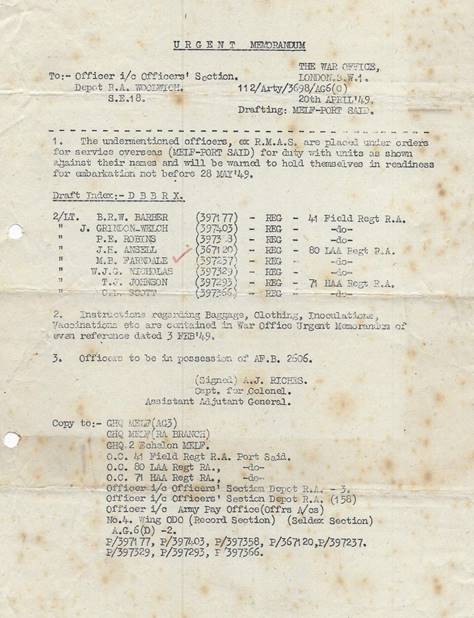
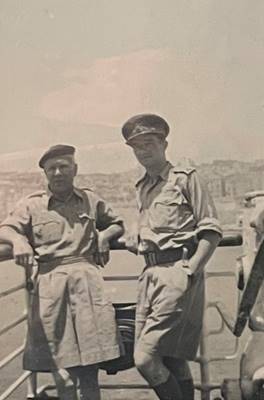
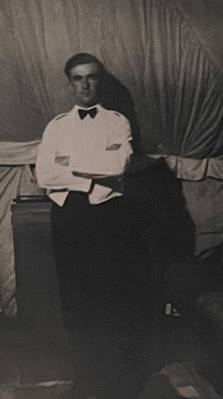
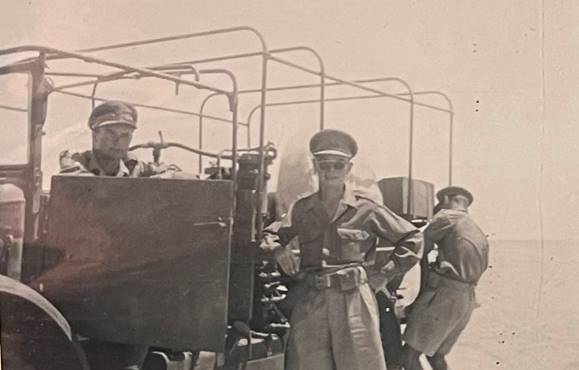
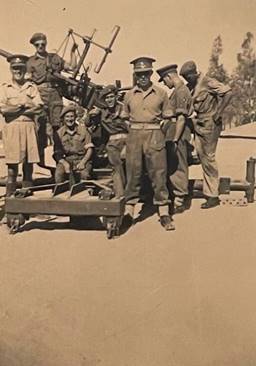
On the Troop Ship to Egypt A young officer
with 80th LAA Regiment
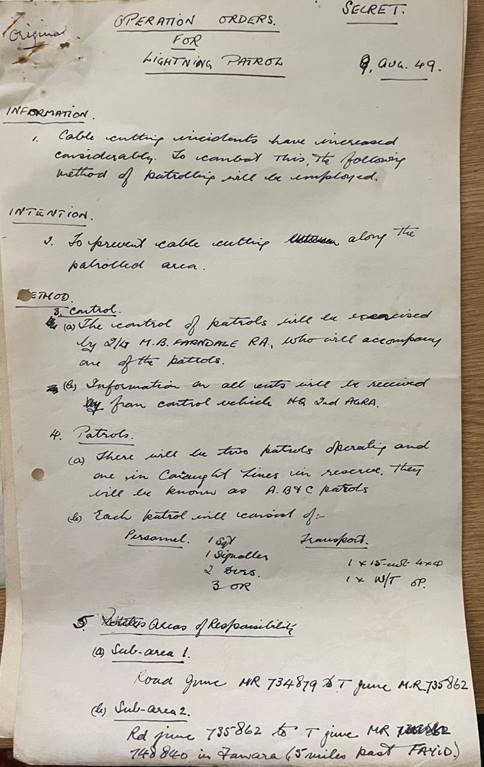
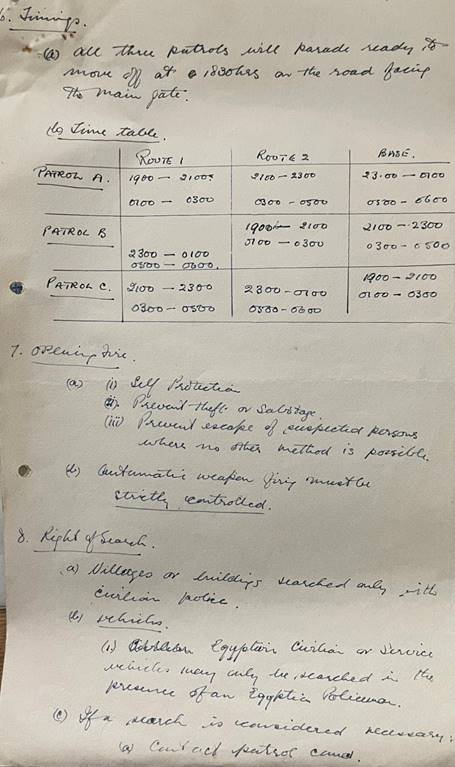
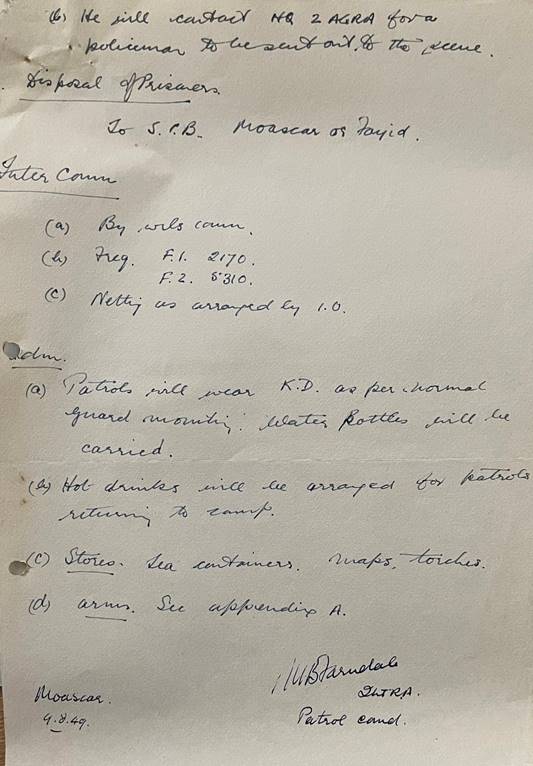
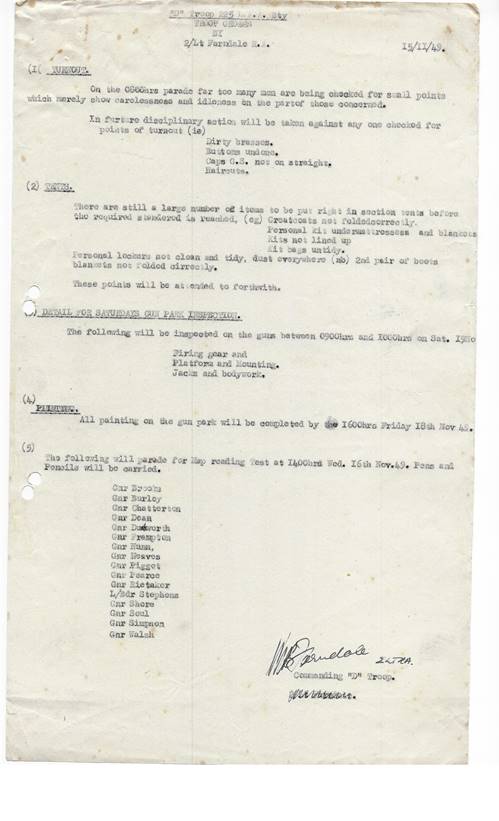
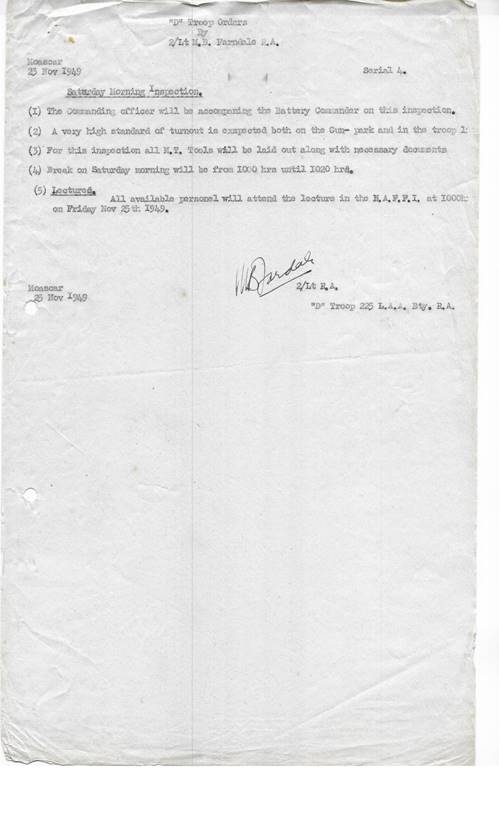
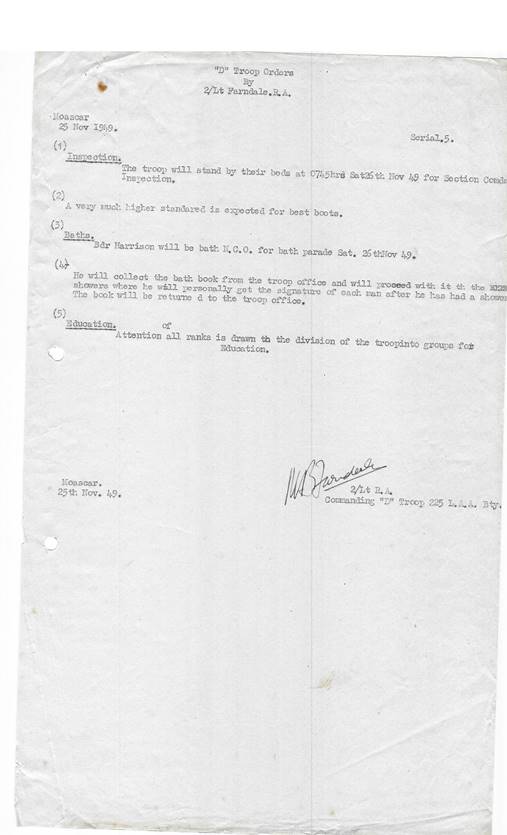
1950
Soon he was selected for the elite Royal Horse Artillery and he joined First Regiment Royal Horse Artillery
in 1950.
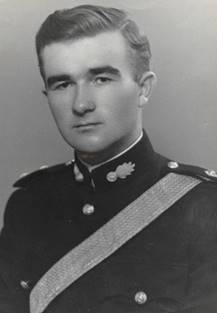
Second Lieutenant Martin Farndale RHA, 1950, aged 21
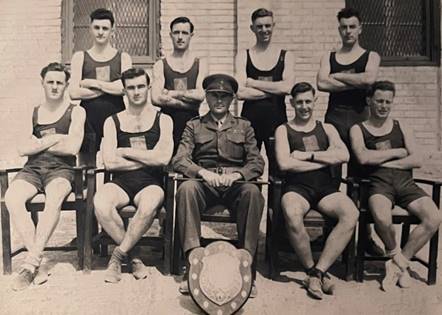
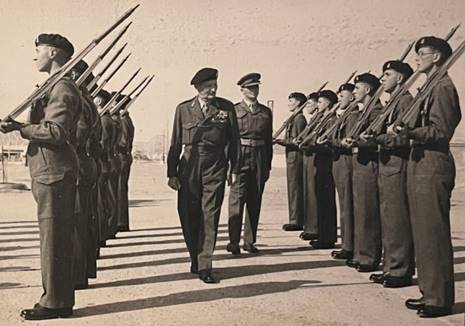
The Athletics Team
Field Marshall Montgomery (“Monty”) inspects Martin Farndale’s Troop,
Fayid, Egypt
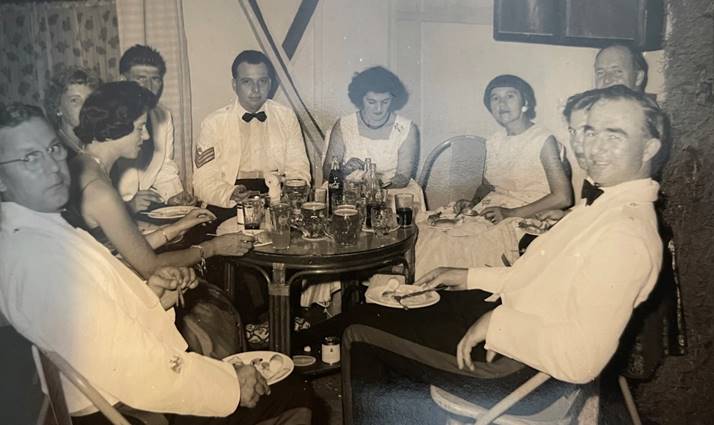
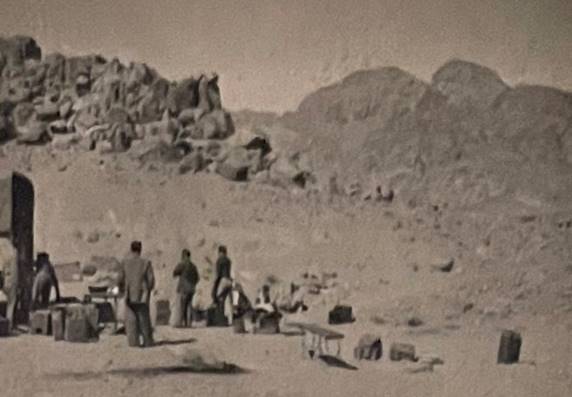
Martin Farndale (right) and Anne Buckingham (second left) at
the Ryal Artillery Ball, Fayid, Egypt On
exercise in the Sinai
Germany
The
regiment returned from Egypt in 1951 to the British Army on the Rhine. He
served in E Battery and then in B Battery.
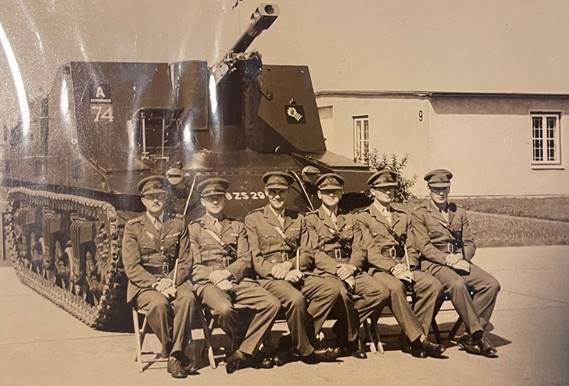
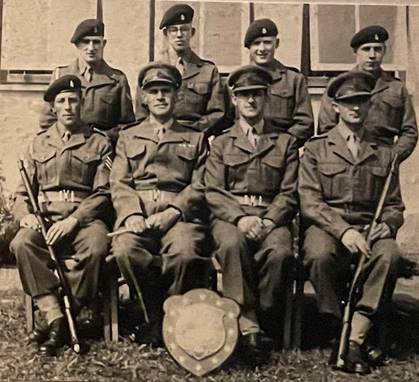
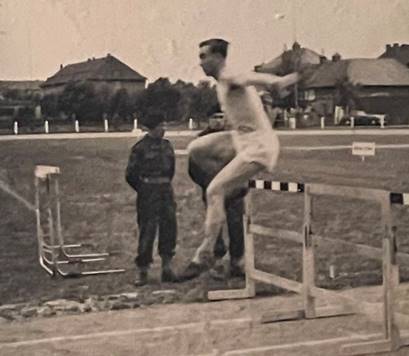
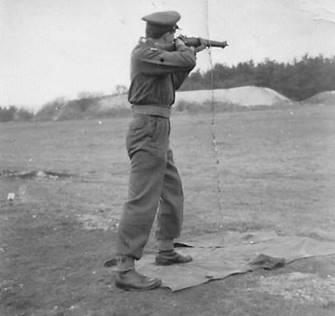
There
is a separate page about Martin Farndale and First Regiment
Royal Horse Artillery.
1952
Martin
was Best Man at the Davidge wedding:
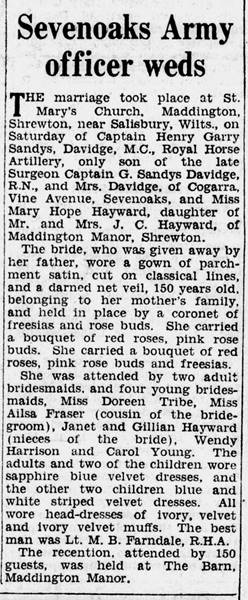
(Sevenoaks Chronicle and Kentish Advertiser, 1 February
1952)
1954
He was then posted to the Royal Artillery Staff of 7th
Armoured Division at Verden in Lower Saxony, from 1954 to 1957.
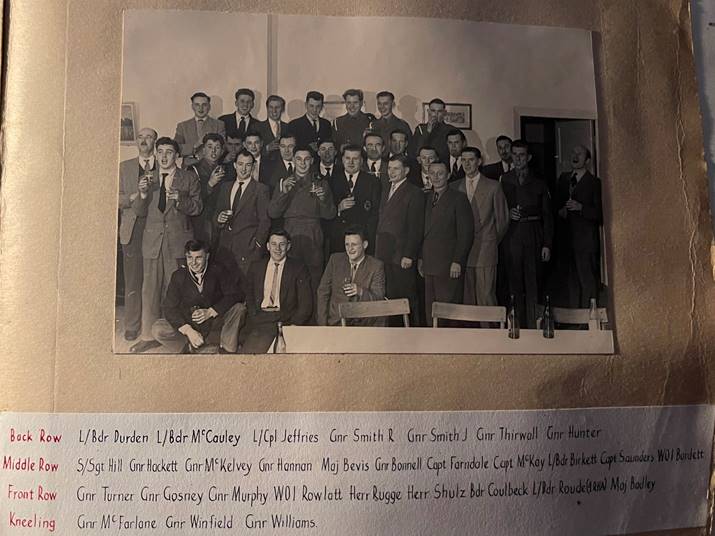
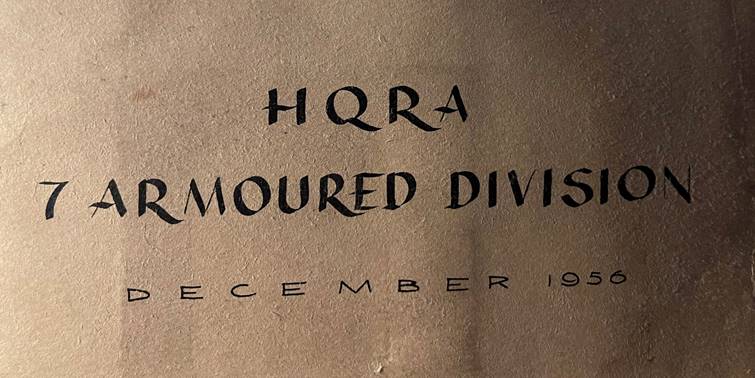

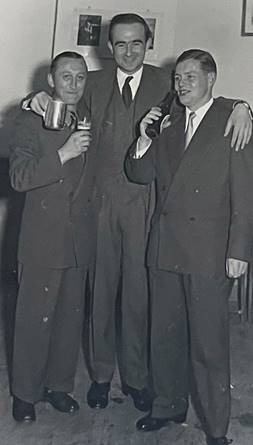
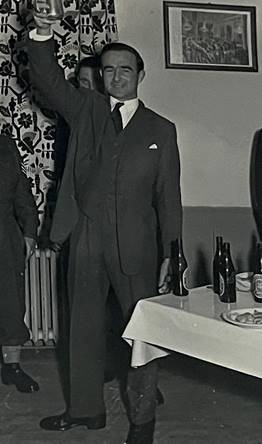
He then served with 53rd (Louisberg) Battery and as Adjutant
of 22nd Light Anti-Aircraft Regiment (which he used to affectionately call
"22 Light ack ack").
1955
Married
Martin Baker Farndale, age 26, bachelor, Captain Royal
Artillery of Gale Bank Farm Wensley
Yorkshire, son of Alfred Farndale,
farmer, married by Banns Margaret
Anne Buckingham, age 27 spinster of Mill House, Findon daughter of Percy
Robert Buckingham, contractor. Both signed. Witnesses Reginald Cecil
Chapman, Margaret Louisa Farndale and Etheldreda Annie Buckingham. NW
Lydeker Vicar. The wedding was on 13 August 1955.
There are photographs and other
records of the Wedding of Anne Buckingham and
Martin Farndale.
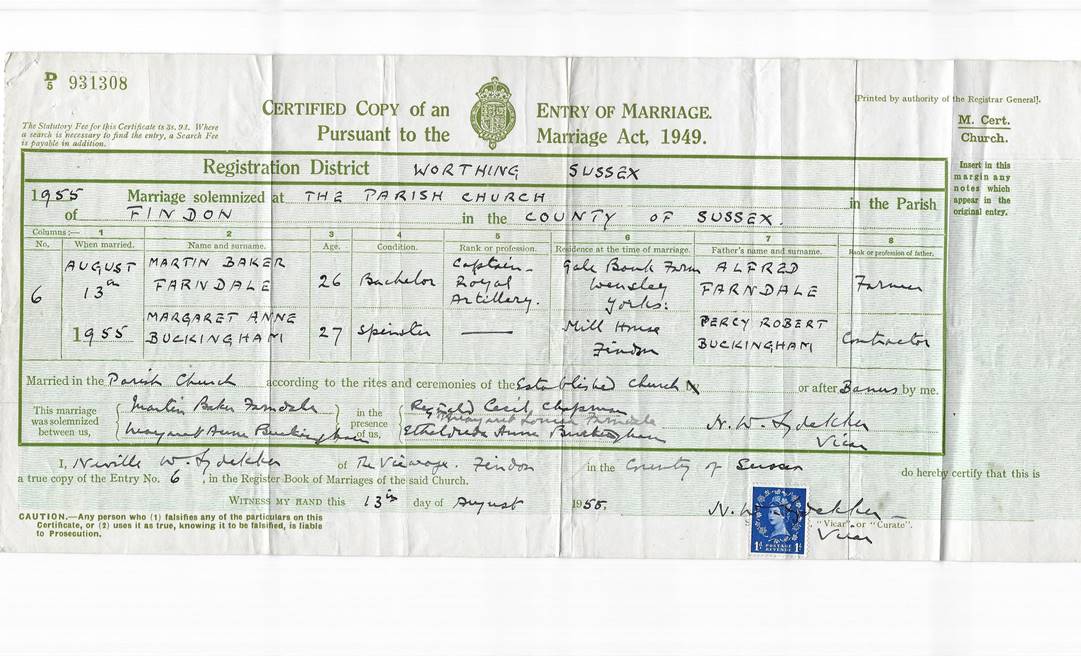
There is a separate page about their
travels together in the 50s and 60s.
1960
Malaysia
17th Gurkha Division, Malaya, Headquarters Royal
Artillery (Major), 1960 to 1962
He then went to the Gunner Staff of 17th Gurkha Division in
Malaya from 1960 to 1962, where he saw active service during the final phases
of the Malayan Campaign.
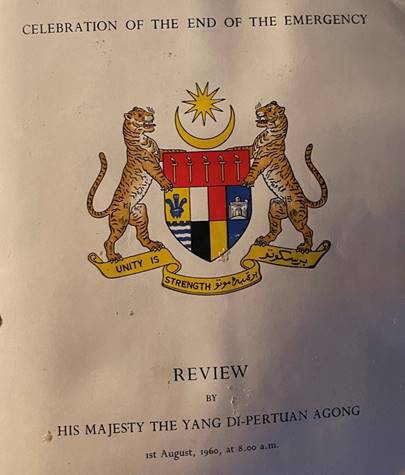
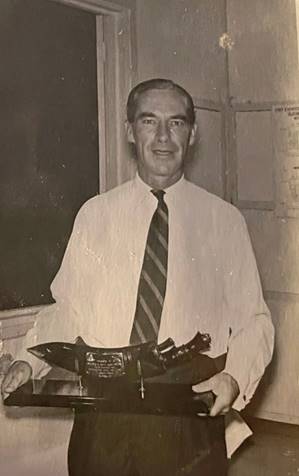
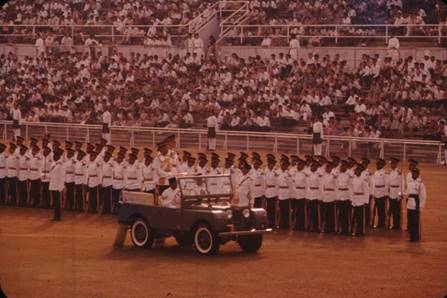
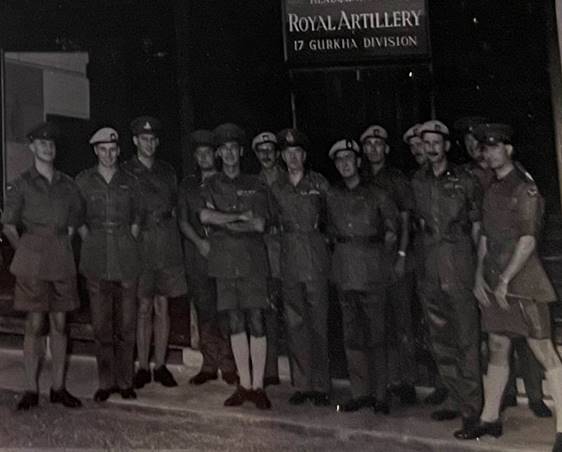
The End of Emergency
Celebration 1 August 1960
Farewell to Brigadier R Keith Jones, CRA 1961 Freedom
Parade
Headquarters Royal Artillery, 17 Gurkha Division, 1962
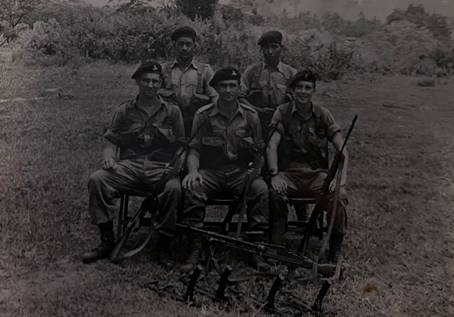
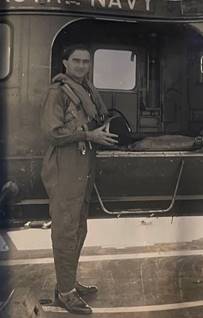

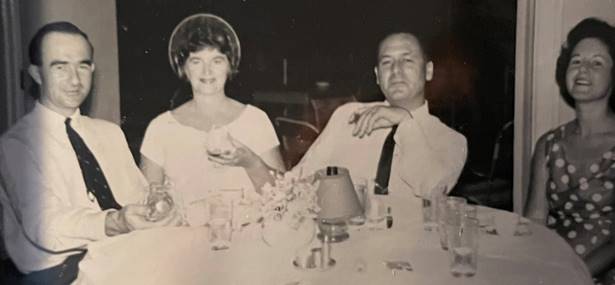
1961
The HQRA Rifle Team 1961
Major Farndale, HMS Victorious, South China Sea, 1961 Martin and Ann Farndale, Dougie and Nora Mitchell, Singapore 1961 With the Howards in Singapore, 1961
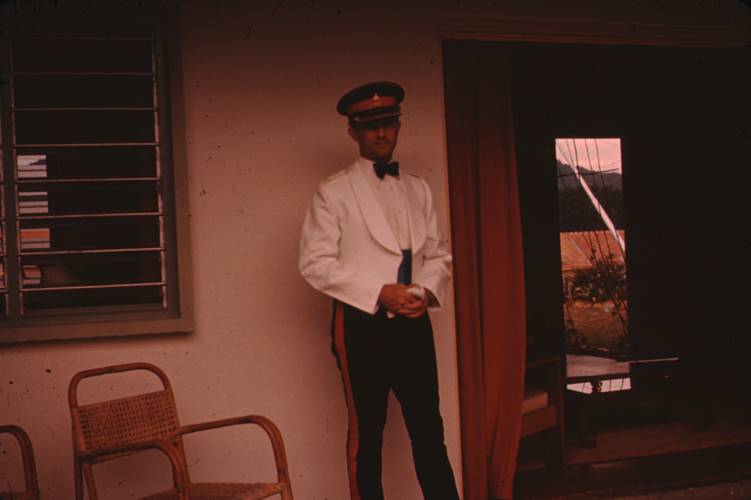
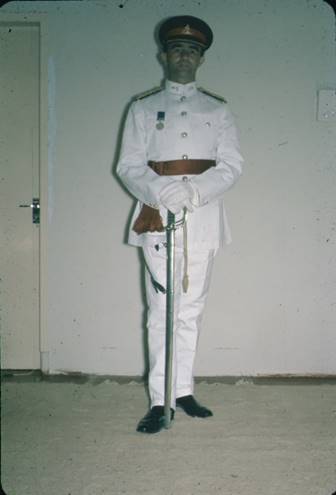
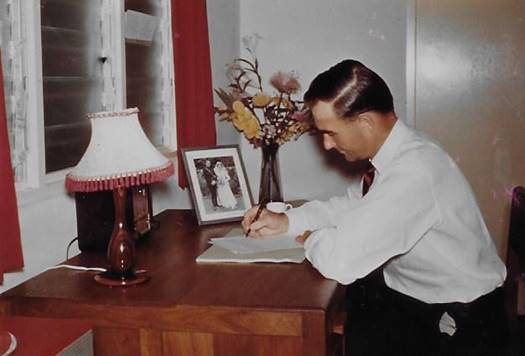
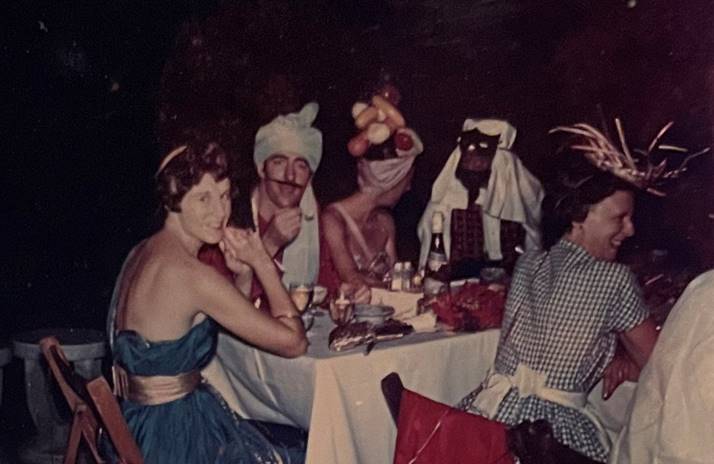
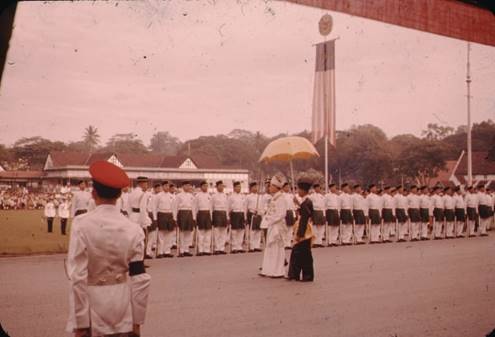

New Year Party, Seremban, Malaya, 1961
Victory Parade
On exercise
There is a separate page which
includes photographs and records of their travels around South East Asia
during this time.

Overland
from Malaysia to UK
After their posting to Malaya, Martin and Anne Farndale
drove home overland in a Ford Prefect in a remarkable journey and you can read
more about the
Journey on a separate page.
They travelled by car from Malaya to Burma, to Calcutta,
across India with a flight to Kathmandu and the Himalayas, across Pakistan,
Iran (through Isfahan and Tehran), across the length of Turkey to Istanbul, to
Ephesus by sea and then to Athens, and then back home via Yugoslavia, Venice,
the Alps, Austria, Germany, and Belgium.
1962
Epsom
and London
The War Office, 1962 to 1964
In 1962, he served for two years in the Military Operations
Directorate of the War Office (which then became the Ministry of Defence).
1963
Family
Richard Martin Farndale, Martin and Anne’s only son, was
born at Epson, Surrey on 17 April 1963 (FAR01122).
1964
Germany
First Regiment Royal Horse Artillery, Battery Command (Major), 1964
to 1966
He returned to First Regiment RHA in 1964 to command the
Chestnut Troop, first in Germany (Hildesheim).
The Regiment was equipped with 105 mm pack howitzers.
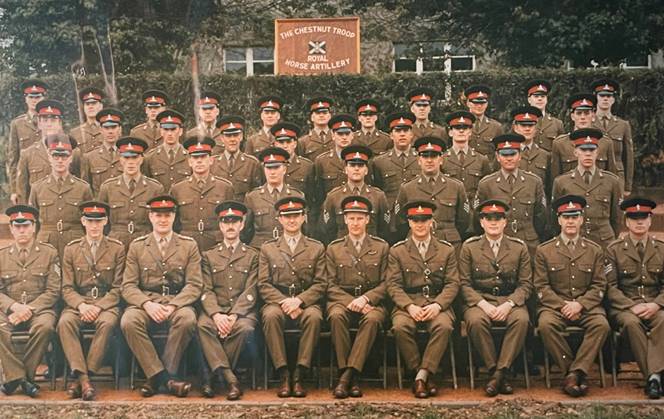
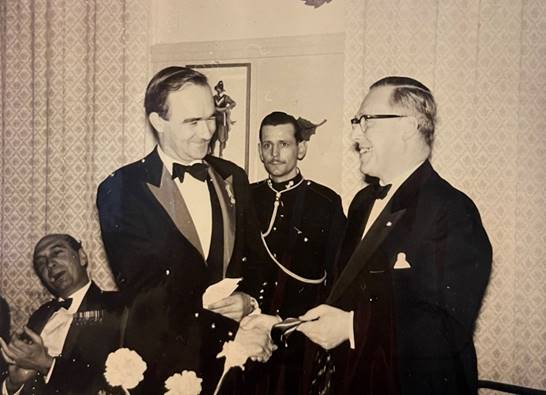
1965
Aden
The Regiment was then posted to Aden during the Radfan
Campaign in the arid mountains of the Protectorate.

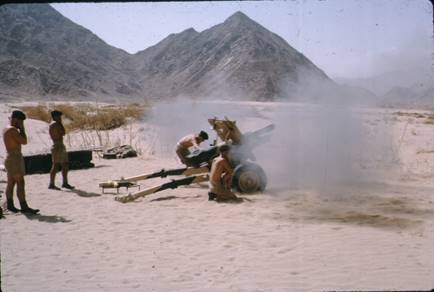
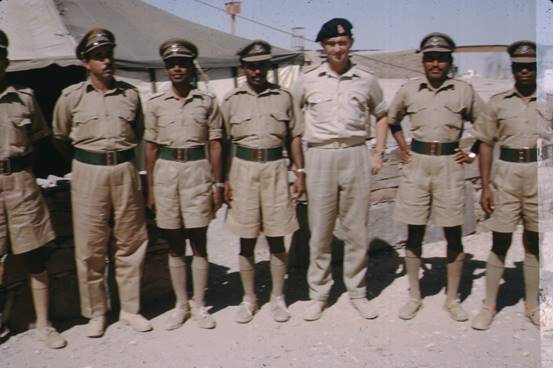
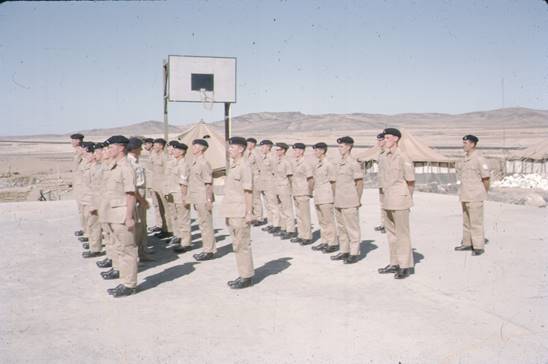
In Aden, he saw action against tribesmen in the Radfan
mountains, bordering the Empty Quarter.

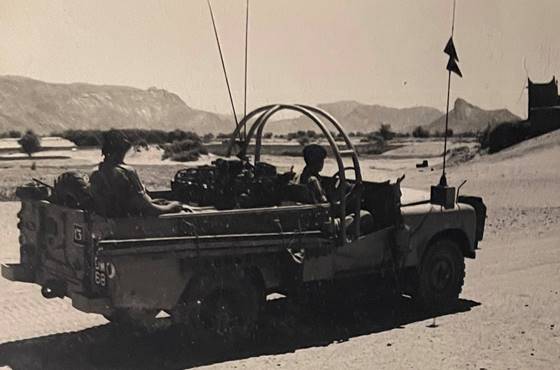
Tobruk Section, Chestnut Troop in South Arabia, November
1965 The Battery Commander’s land rover, Border patrol, 1965
1966
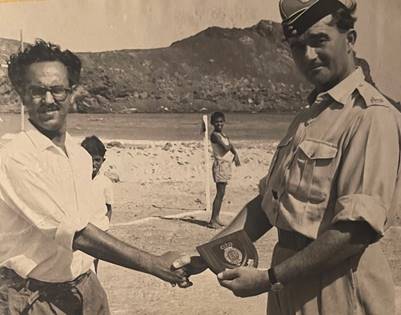
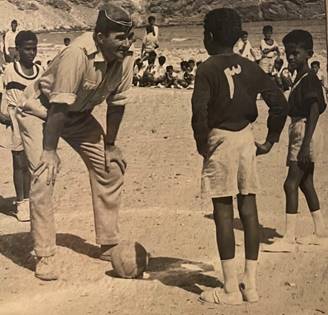
Liaison with the local school, Little Aden, May 1966
There is a separate page about Martin
Farndale and First Regiment Royal Horse Artillery.
Staff College Instructor, 1966 to 1969
Camberley
After Battery Command, he went back to the Staff College for
three years as an instructor from 1966.
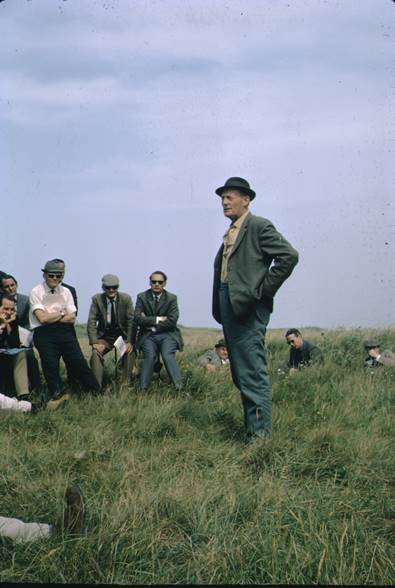
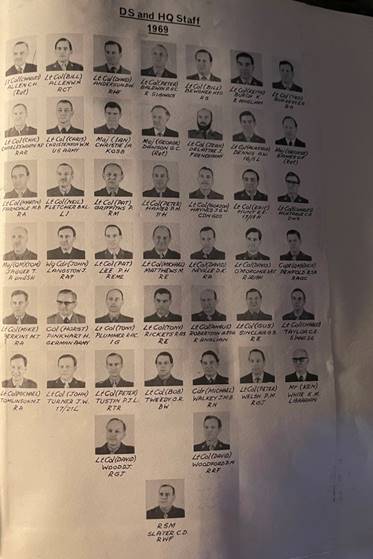
Staff College battlefield Tour (%0 Division Tour) – Stan
Hollis VC
1969
First Regiment Royal Horse Artillery, Commanding Officer
(Lieutenant Colonel), 1969 to 1971
Northern
Ireland
From 1969 to 1971, he was given command of First Regiment.
He was the first artillery commanding officer to take his regiment to Northern
Ireland and to serve in an infantry role on the streets of Belfast. He was also
the first Lieutenant Colonel to command a warship. Accommodation was sparse in
those early days, so HMS Maidstone, which was destined for the breaker's yard,
was instead sailed from Portsmouth to Belfast and acted as a maritime barracks
for the Regiment. His command included a hundred sailors, the Maidstone's
maintenance team. Also during his command, the
Regiment was granted the freedom of the City of Nottingham and a parade took
place through the city on 22 April 1970. There is a painting by Terence Cuneo
of the parade (Martin got to know Terence Cuneo very well during his career and
was involved in the commissioning of many of Cuneo's military paintings). After
Northern Ireland, Lieutenant Colonel Farndale took the Regiment to Detmold in
Germany, where the Regiment was equipped with the Abbot self propelled gun.
There is a separate page about Martin
Farndale and First Regiment Royal Horse Artillery.
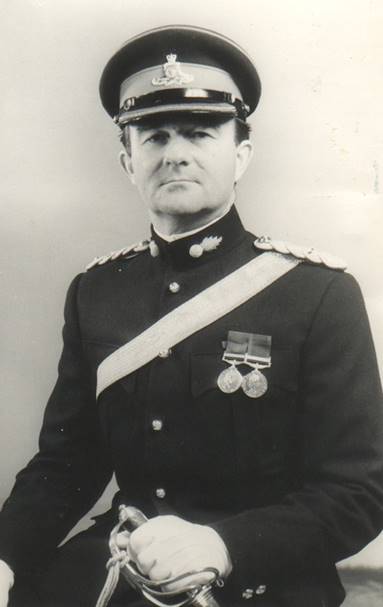
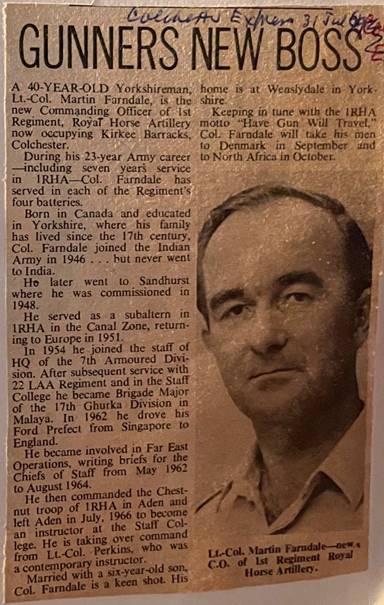
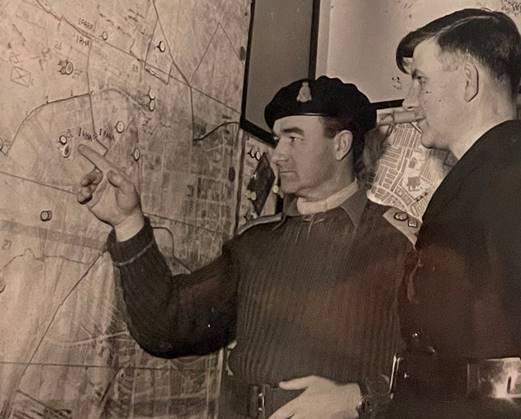
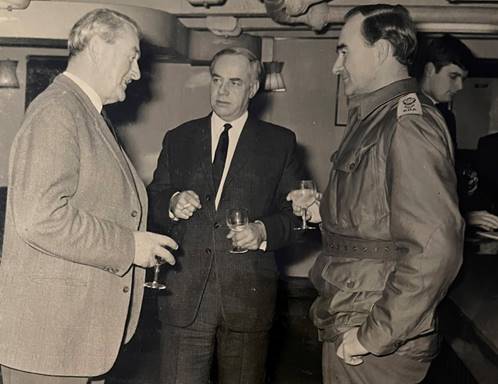
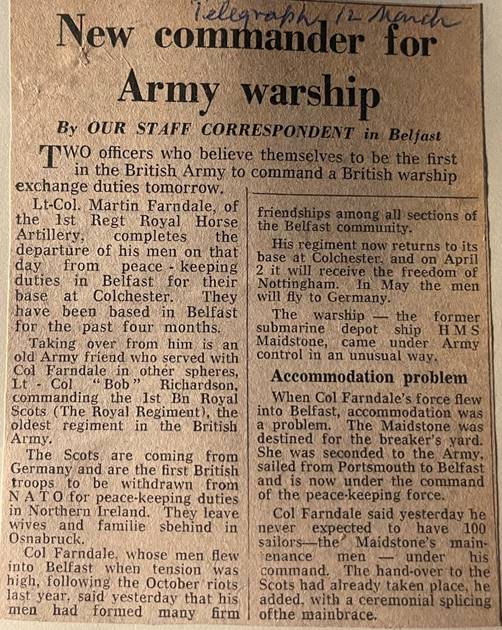
Northern Ireland
1970
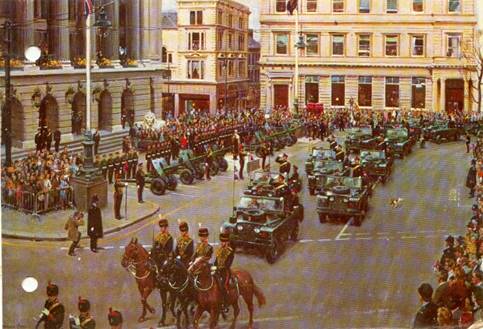
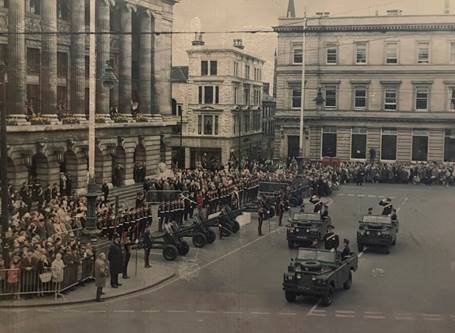
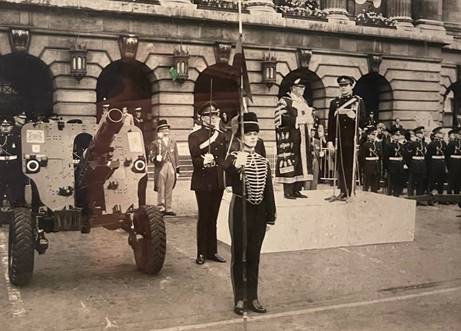
The Freedom of the City of Nottingham
Germany
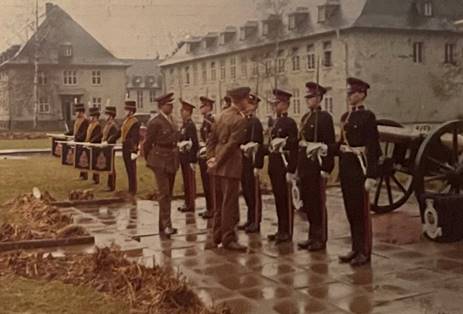

Detmold, West Germany
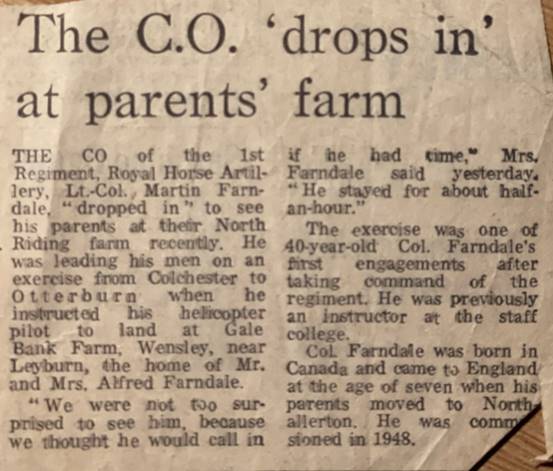
1971
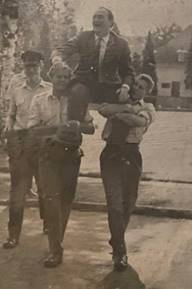
Farewell to 1 RHA
London
Defence Policy Staff, Ministry of Defence, 1971 to 1973
Next
he had two years on the Defence Policy Staff in the Ministry of Defence.
1972
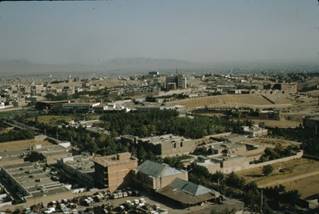
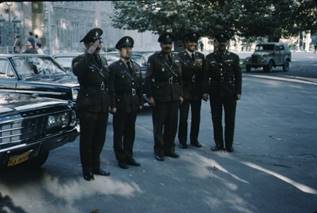
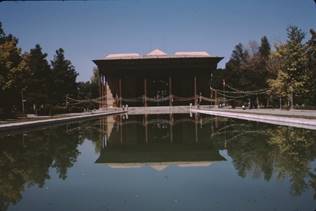

Tehran
Persian Officers
Isfahan
Persia Staff Talks 1972
1973
Germany
7th Armoured Brigade (The Desert Rats), Brigade
Commander (Brigadier), 1973 to 1975
In 1973, he was promoted to Brigadier. The focus of his
military career was with the British Army of the Rhine in then West Germany. He
commanded 7th Armoured Brigade (The Desert Rats) from December 1973 to December
1975. The Headquarters was in Soltau, Lower Saxony and he lived at the Jagd
Haus Weiss (originally the hunting lodge of the Weiss family) at Marbostel,
near Soltau. He planned the Brigade Exercise, Red Rat 74. He also reorganised
the battlefield headquarters of the Brigade from a large
conglomeration of vehicles, to a more tactical and manoeuvrable
headquarters of 22 vehicles around a 'heart' of 6 armoured vehicles.
There is a separate page about Martin Farndale’s time as Brigade
Commander of 7th Armoured Brigade.

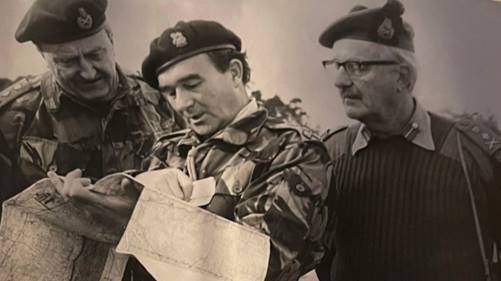
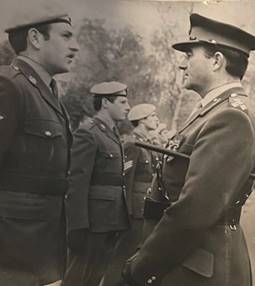
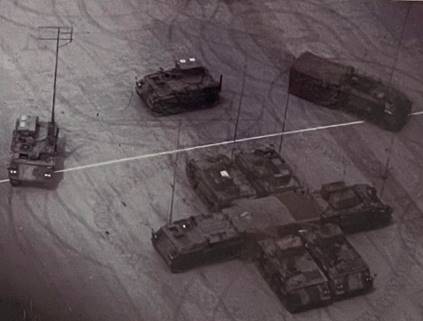
Reduced size Tactical Brigade Headquarters
1976
London
Ministry of Defence, 1976 to 1980, Director of Public Relations (“DPR”)(Brigadier) and Director of Military Operations
(“DMO”)(Major General)
In New Year 1975/76 he moved back to the Ministry of Defence
as Director of Military Operations (1976 to 1978).
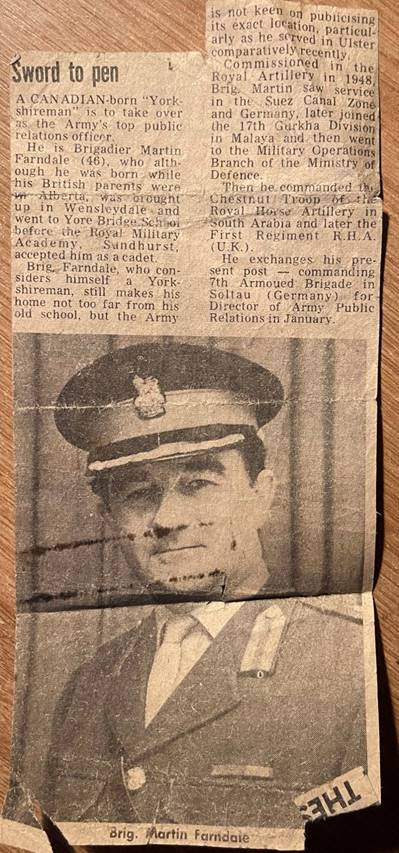
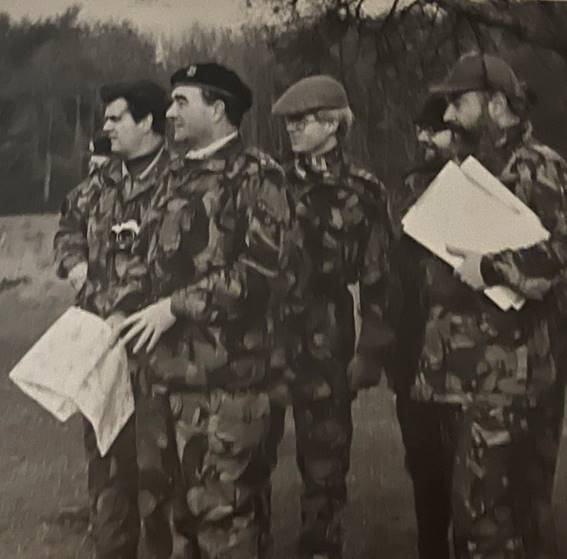
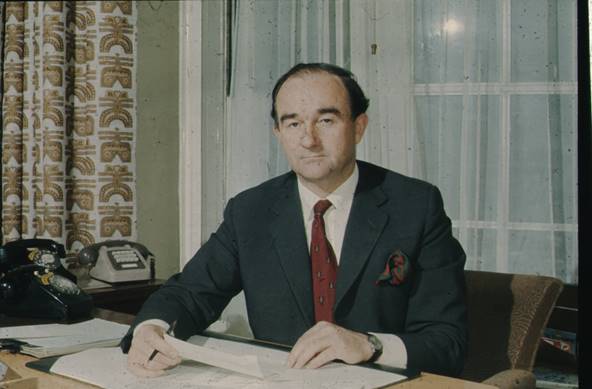
With the Press, Exercise Spearpoint 1976 (Harry Greenfield, Sunday
Telegraph extreme right)
Brigadier Farndale,
DPR (Army)
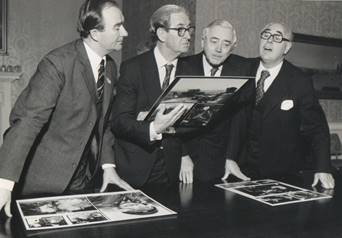
Judging the annual photographic competition in 1976
1978
In 1978, he was appointed as Director of Military Operations
in the rank of Major General (1978-1980). He was DMO during the final phases of
the guerrilla campaign in Rhodesia after Ian Smith's unilateral declaration of
independence. He was largely responsible for setting up the British Monitoring
Force which helped to end the guerrilla war and bring about an independent
Zimbabwe. He was also responsible for considering the increased military
requirements for dealing with a spiralling illegal immigrant problem in Hong
Kong.

1979
In his role as Director of Operations at the Ministry of
Defence Martin Farndale had to organise the disarming of guerillas in order to facilitate the creation of the future nation of
Zimbabwe.
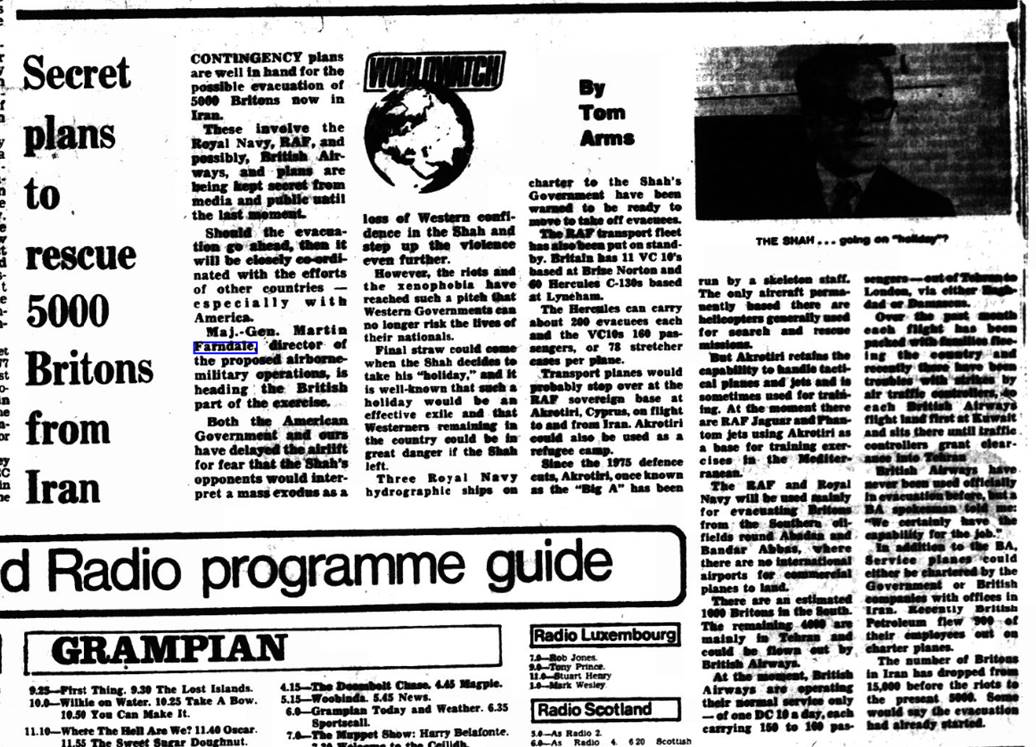
(Press and journal, 5 January 1979)
The Rhodesia Ceasefire:

(The Scotsman, 11 December 1979)
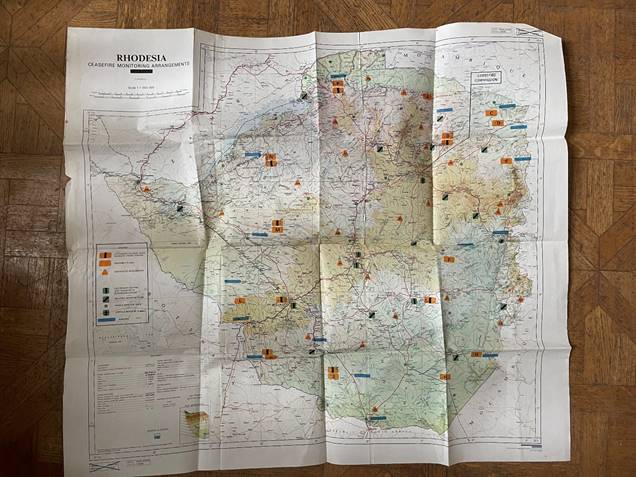
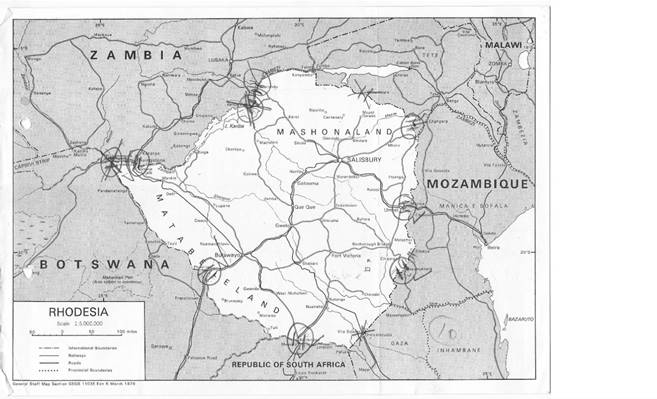
The map used by Martin Farndale as DMO to produce the
ceasefire plan for Rhodesia, November to December 1979 The map
marked up by General Walls at a meeting with Martin Farndale to resolve the
knotty cross border problem at the eleventh hour on 12 December 1979
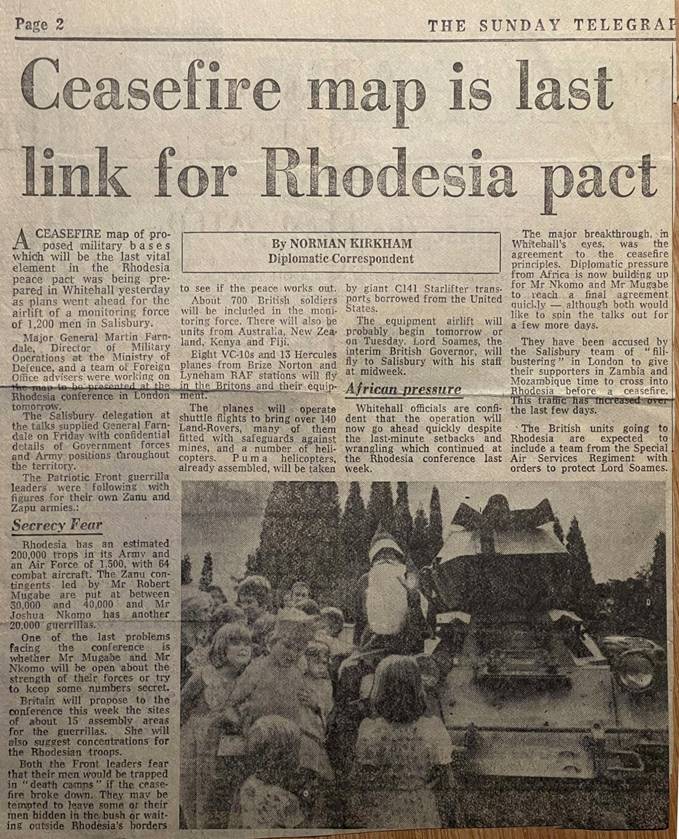
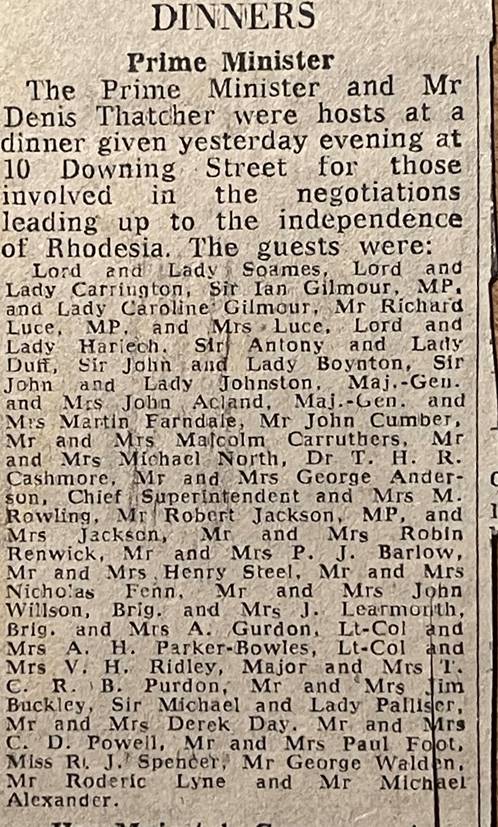
1980
The Army Air Corps, Colonel Commandant, 1980 to 1988
In 1980 he became Colonel Commandant Army Air Corps. He
learnt to fly a helicopter and built up a considerable log of flying time,
particularly during his later commands in Germany. He continued in that post
until 1988.
There is a separate page about Martin
Farndale as Colonel Commandant of the Army Air Corps.

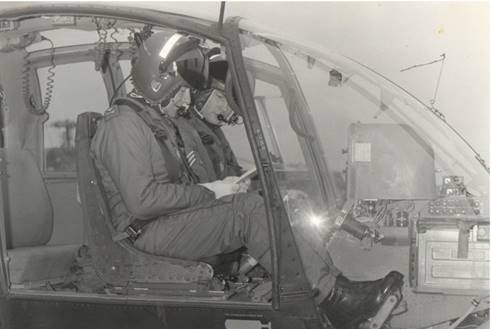
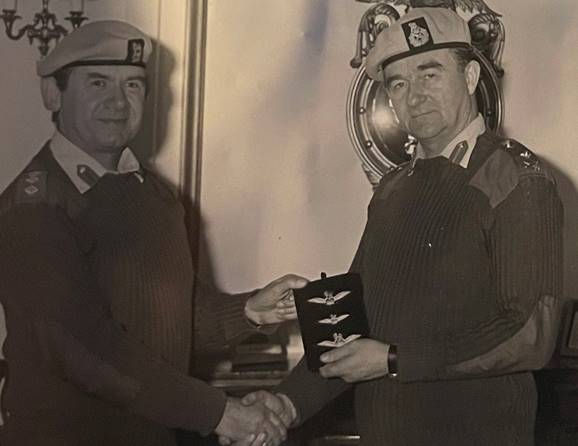
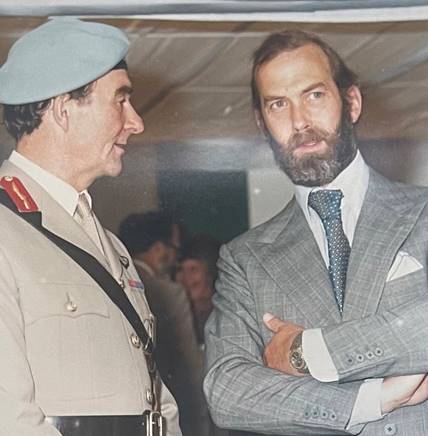
Learning to fly
Receiving his wings at Middle Wallop from Colonel Mike Badger, 1980 With the Duke of
Kent

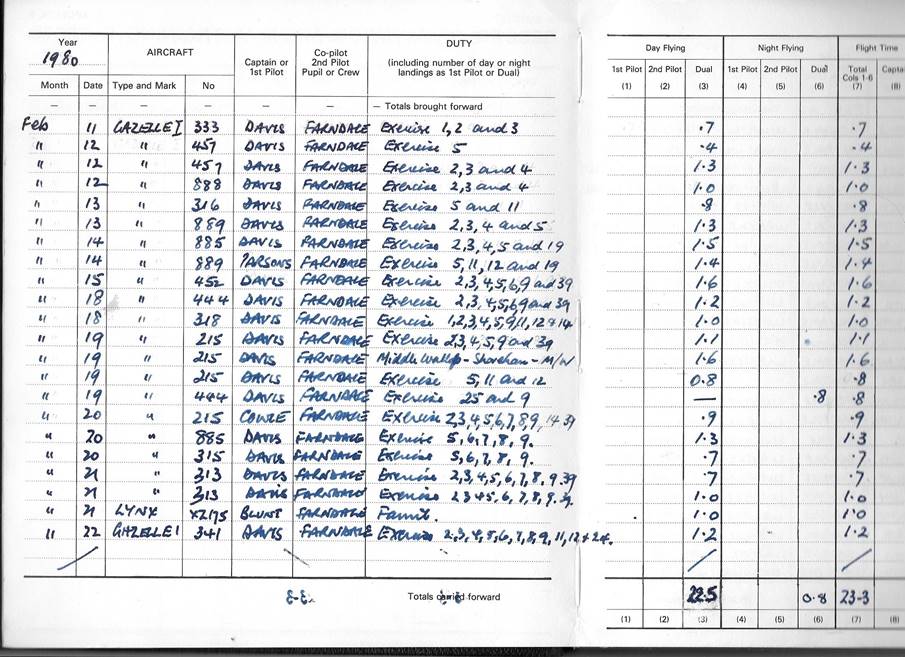
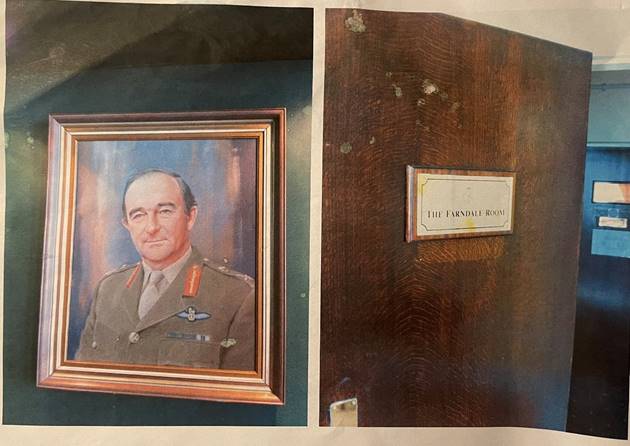
Germany
2nd Armoured Division, Commander (Major General), 1980
to 1983
He commanded 2nd Armoured Division as Major General from
June 1980 to March 1983. The Headquarters was in Lubbecke
and he lived at Cross Keys House, a house of remarkable architecture with no
corners and curved edges. He commanded the Division during Exercise Spearpoint
in September 1980, during which the Division's 14,000 men and 150 tanks took
the full weight of an enemy 'Orange' simulated Soviet break-in. He also planned
Second Division's Exercise Keystone in November 1982.
There is a separate page about Martin
Farndale as Commander of Second Armoured Brigade.
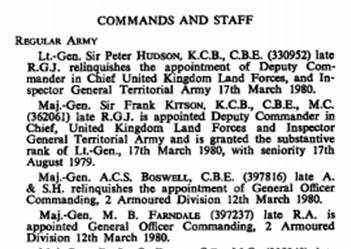

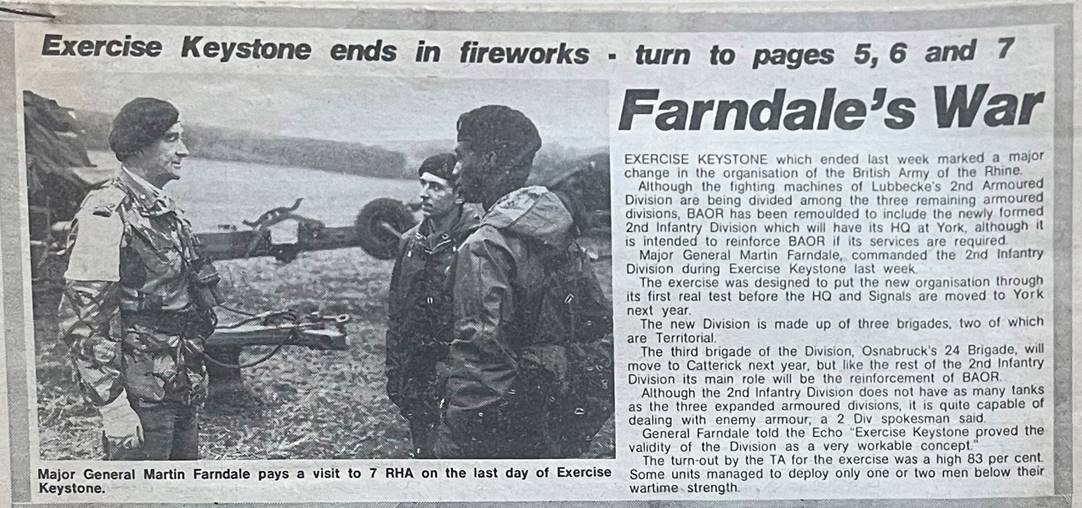
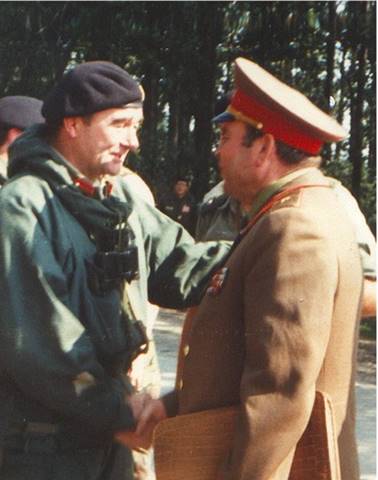
Major General Farndale meets a Russian General observer
during Exercise Spearpoint 1980
1983
1 (British) Corps, Commander (Lieutenant General), 1983 to 1985
He commanded 1st (British) Corps as Lieutenant General from
March 1983 to 1985. This was the fighting component of the British Forces in
Germany, still during the height of the Cold War. The Headquarters was at Bielefeld and he lived at Spearhead House. In those days, tests and demonstrations of ability to withstand an invasion
from the east were critical to keeping the peace and winning the Cold War. In
1984, he devised and oversaw the vast Exercise Lionheart, a show of strength of
the height of the Cold War, which involved 131,000 British troops, including
tens of thousands or Territorials and Army Reservists and which extended over
3,700 square miles. During a second phase a further 6,300 German, 3,500 Dutch,
3,400 American and 165 Commonwealth (from Australia, New Zealand
and Canada) took part. It was intended to test BAOR's reinforcement plans and
was the biggest military exercise to be held since the Second World War. In
September 1983, he showed the Prime Minister, Mrs Thatcher, around his Corps
during an exercise, during which now infamous photographs were taken of the
later Lady Thatcher riding in a Chieftain tank.
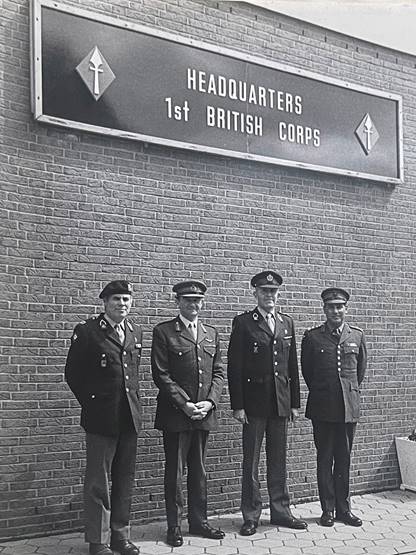

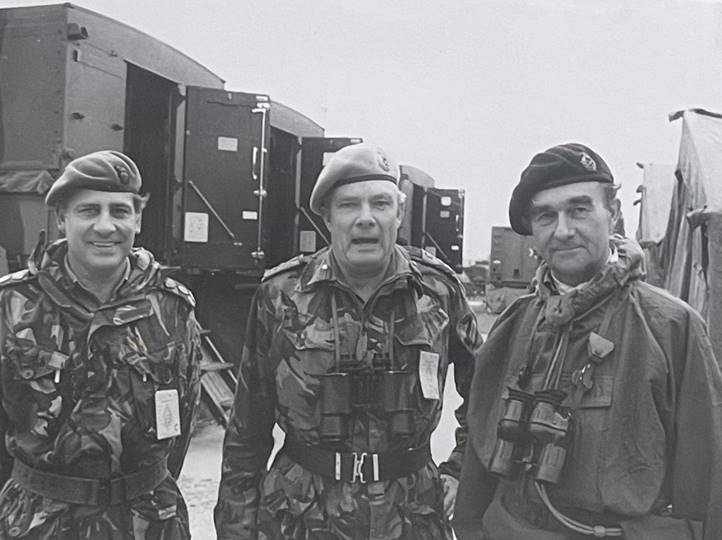
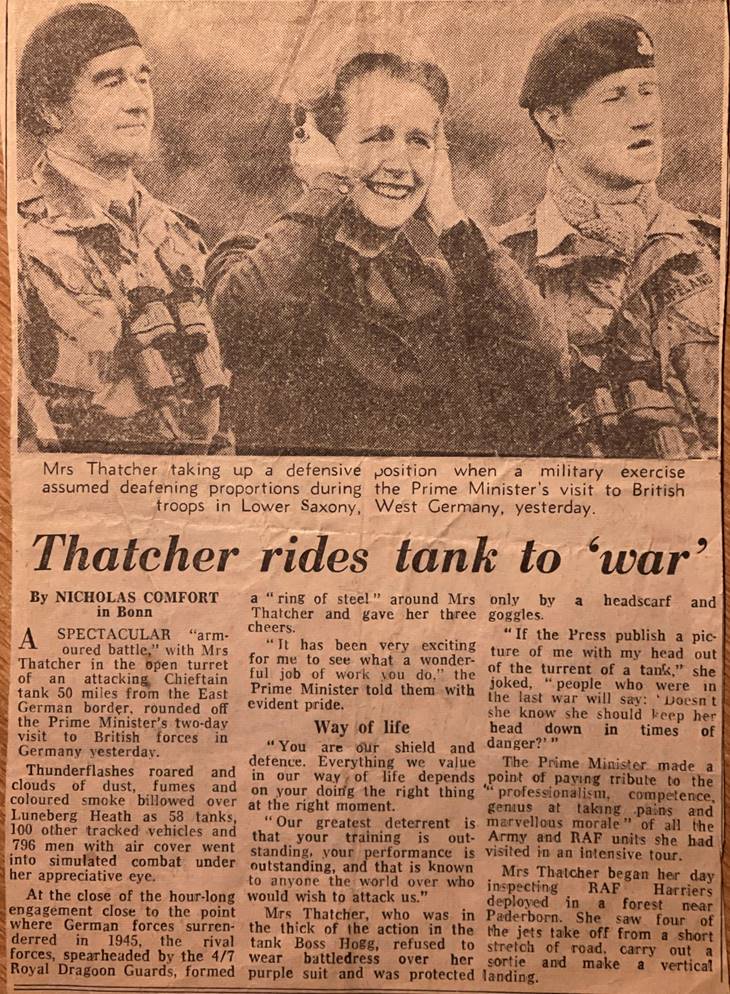

There is a separate page about Martin
Farndale as Commander of 1st (British Corps).
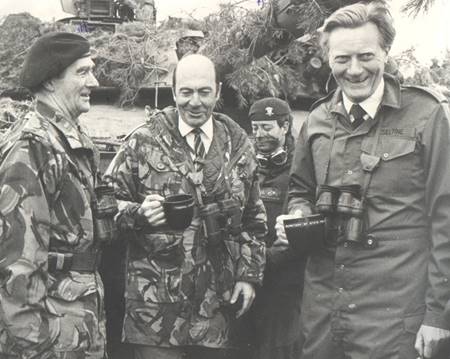
With Michael Heseltine
1985
Commander British Army of the Rhine and Northern Army Group
(General), 1985 to 1987
Finally, he commanded the British Army of the Rhine, at the
time 55,000 strong, and also commanded the Northern
Army Group, an Army Group consisting of a British, Dutch, German, and American
Corps, from its headquarters at Rheindalen. This was from 1985 to 1987. He
lived at Flagstaff House. He worked to implement a revised concept of operations
for the Northern Army Group. In the event of a Soviet invasion, the new plans
would enable NATO forces to 'bide our time and then strike viciously, at the
time of our choosing, at an exposed flank or sector.'
1987
These new plans were
tested in 1987 during another major exercise, Exercise Certain Strike, which
proved itself to be the largest and most complex field exercise of its type
staged in Europe since the D-Day landings in 1944.
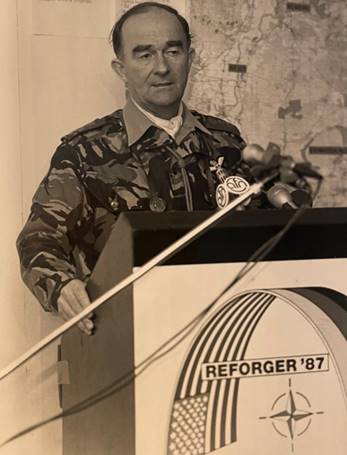
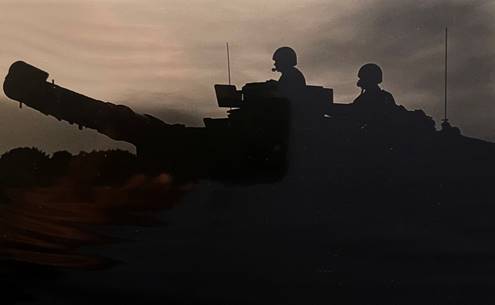
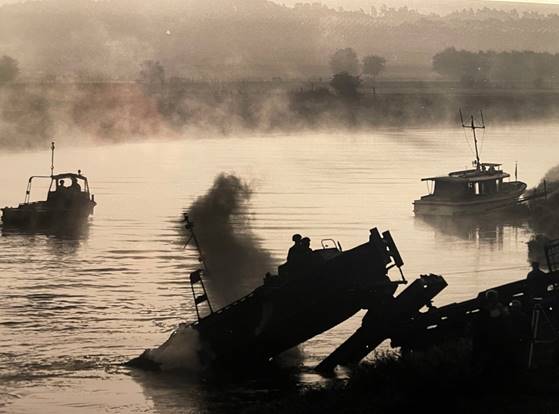
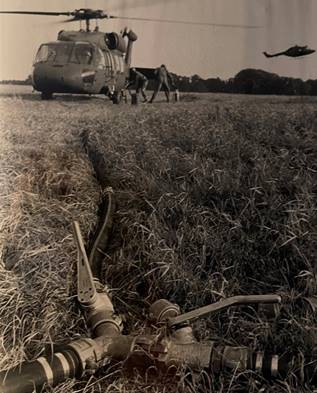
Exercise Certain Strike (also known as Reforger) 1987
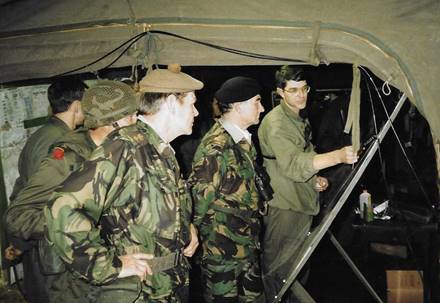
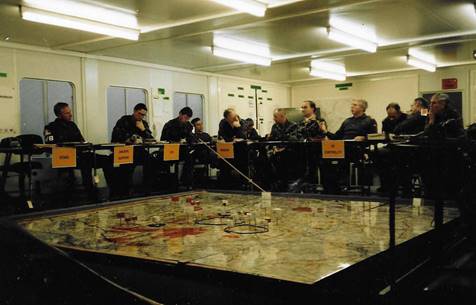
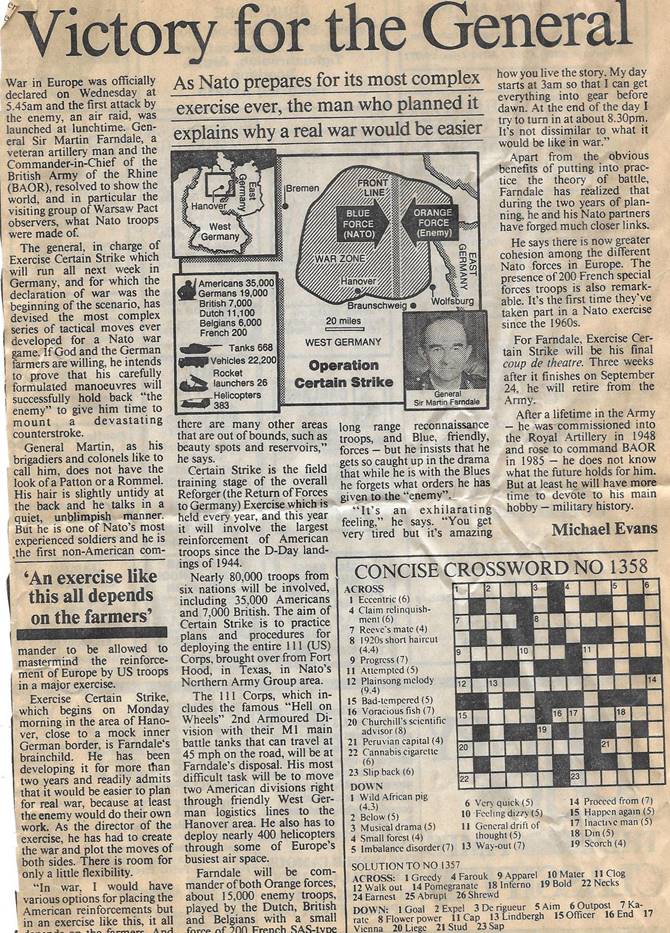
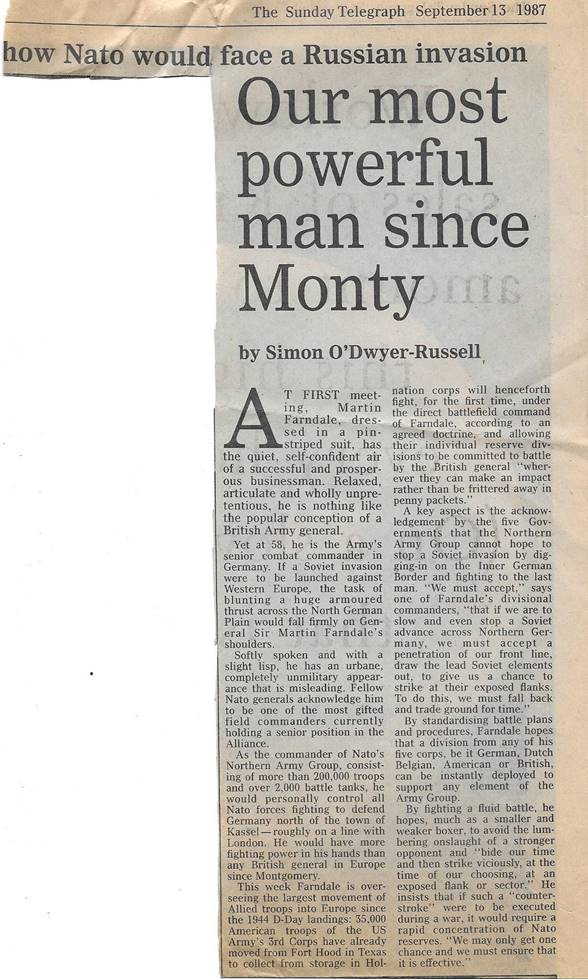
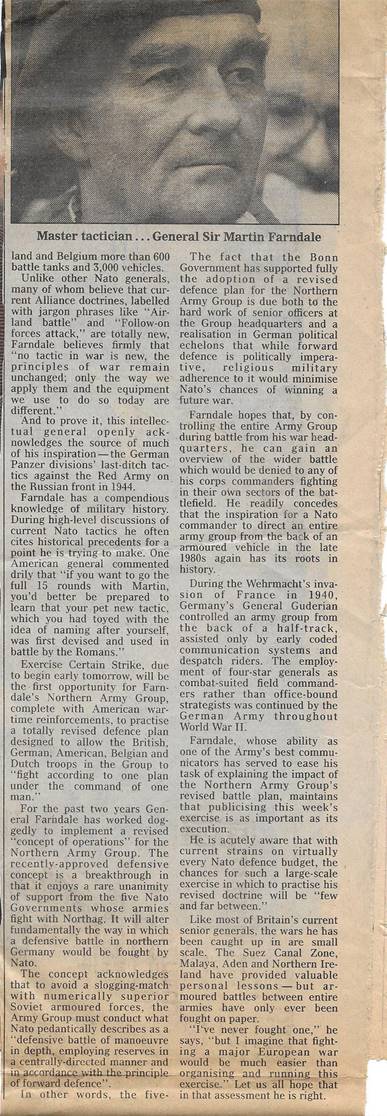
He applied the principles of war in his tactical approach to
the Soviet threat, particularly relative to the concentration of the force
available to him in fluid deep defensive battle. This involved the
concentration of force at the decisive point of the battlefield and the
coordination of the offensive power of armour and infantry with artillery, helicopter and airpower. This culminated in what became
known as the Farndale
Cocktail.
There is a separate page about Martin
Farndale as Commander of the Northern Army Group and the British Army of the
Rhine.
Angmering,
West Sussex
1988
Master Gunner, St James’ Park 1988 to 1996
He became Master Gunner of St James' Park (an office dating
back to the seventeenth century), the honorary head of the Royal Regiment of
Artillery, on 5 November 1988. His principal duty as Master Gunner was to keep
the Queen, the Royal Regiment's Captain General, informed of all matters
pertaining to the Royal Artillery. He was also Colonel Commandant of the Royal
Horse Artillery, Honorary Colonel of First Regiment Royal Hose Artillery and of
Third Battalion, the Yorkshire Volunteers, his home county. He was Colonel
Commandant of the Army Air Corps. He also had a close interest in the South
Notts Hussars.
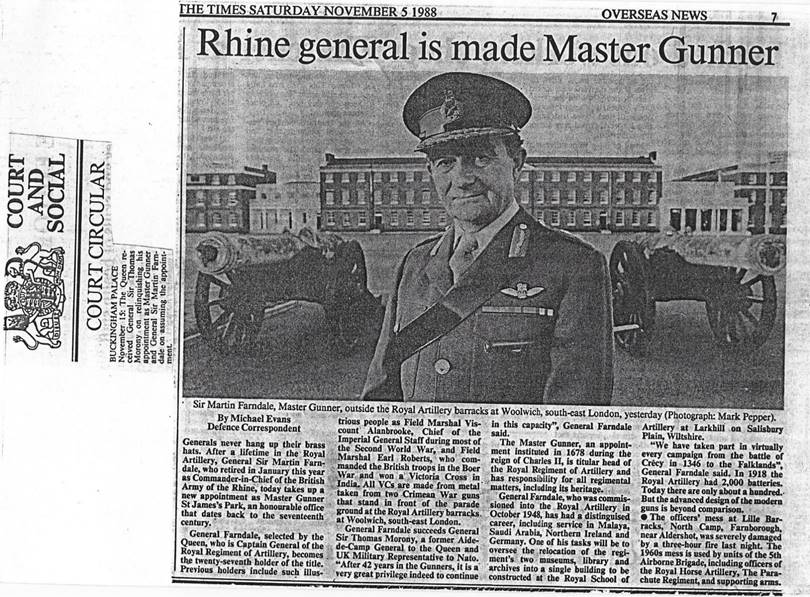
1990
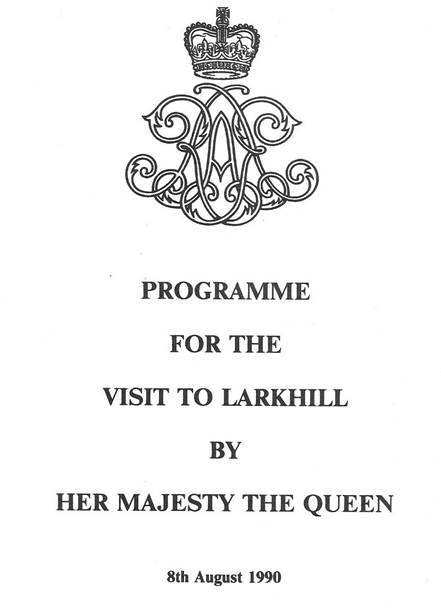
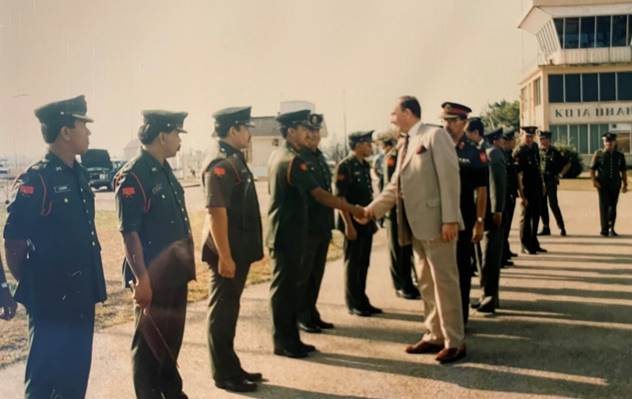
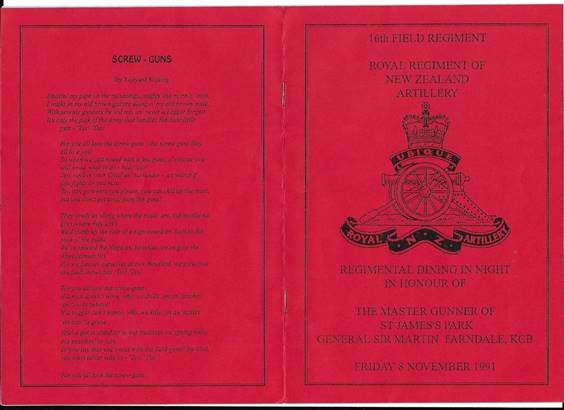
Visit to the Sultan of Kelantan, Malaysia, March 1990
1993
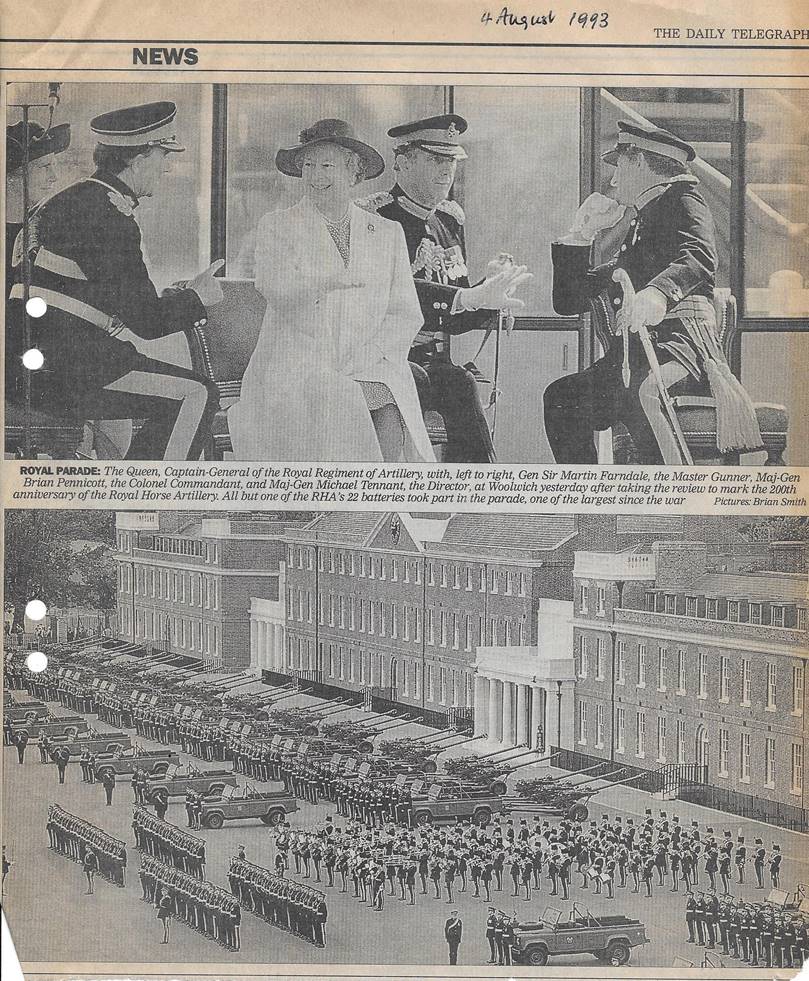
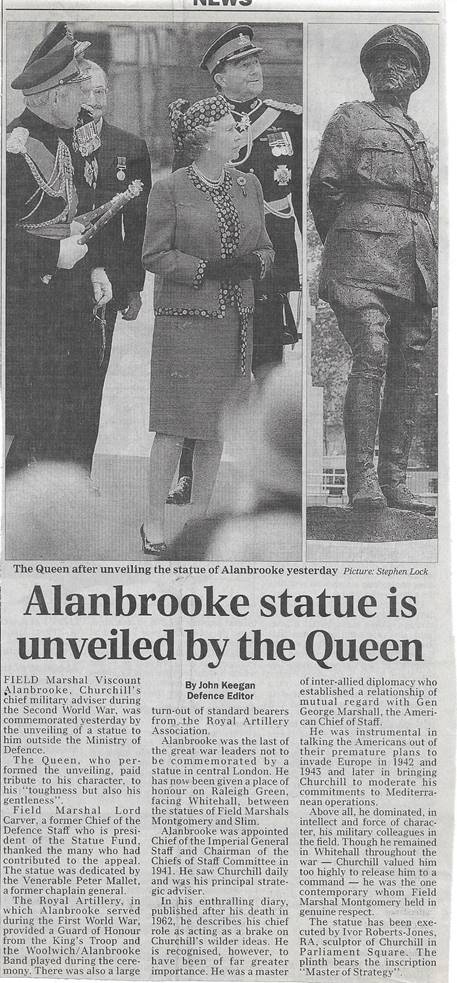

Splitting his sides with laughter beside the Queen in 1991
There is a separate page about Martin
Farndale’s time as the Master Gunner, St James’ Park.
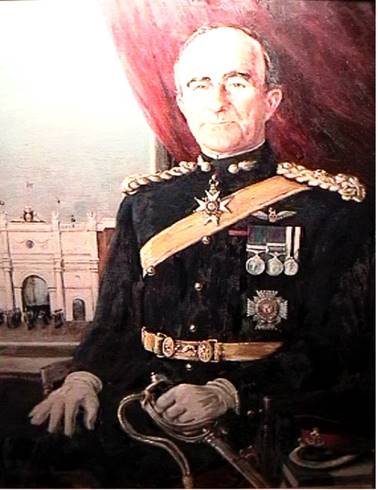
1996
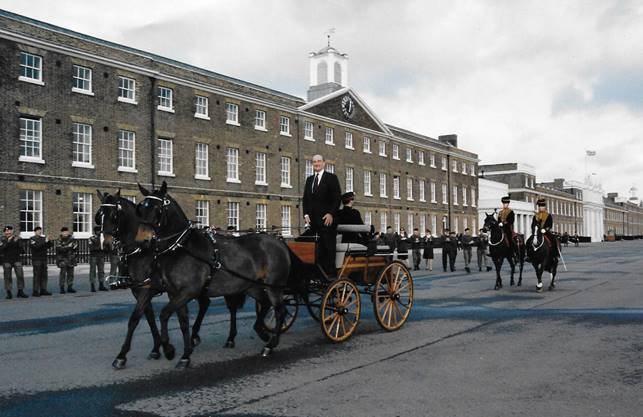
Farewell as Master Gunner
Arguing the case against Defence Cuts in the 1990s
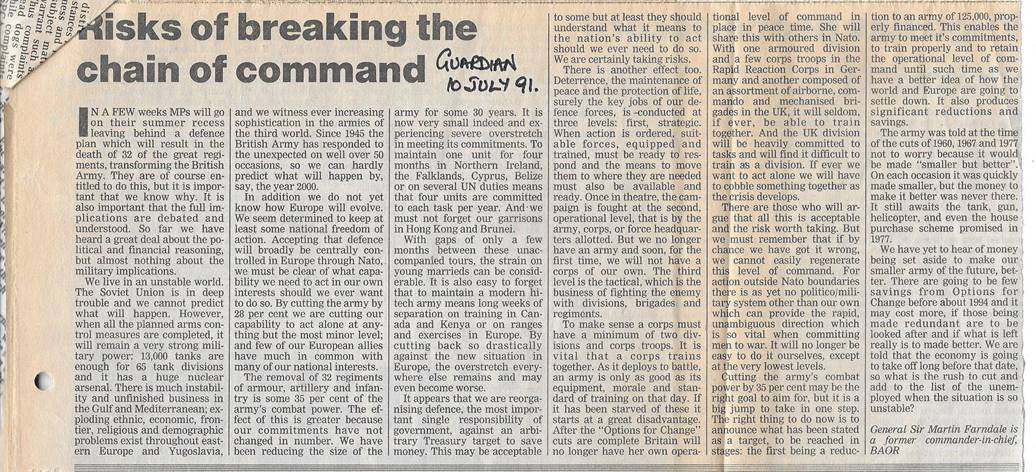
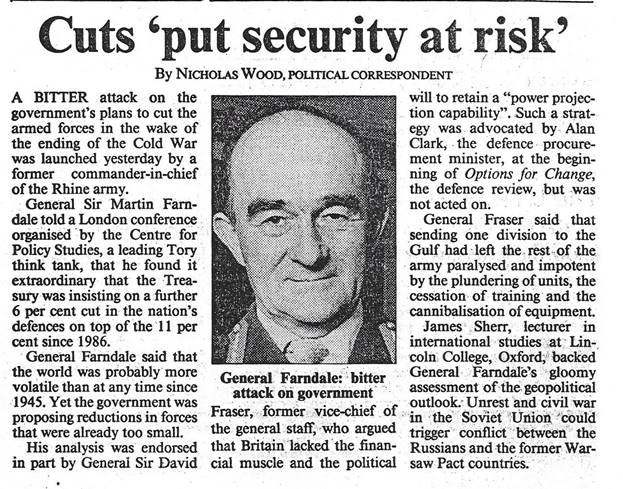
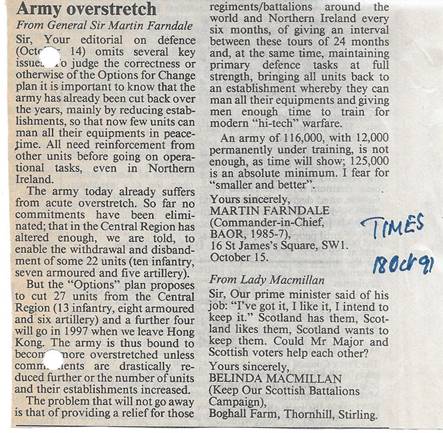
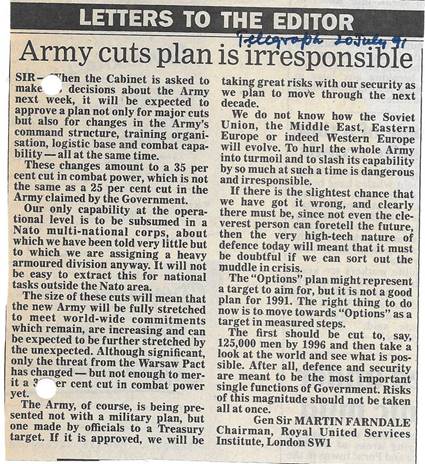
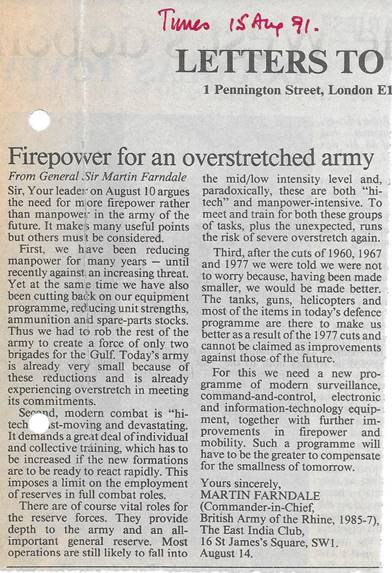
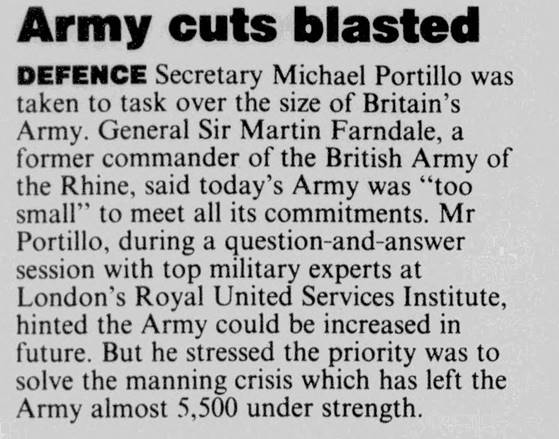
(Huddersfield Daily Examiner, 24 April 1997)

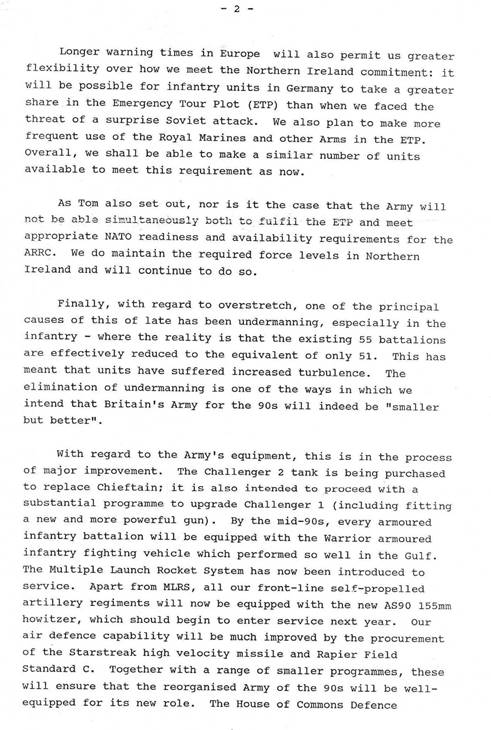
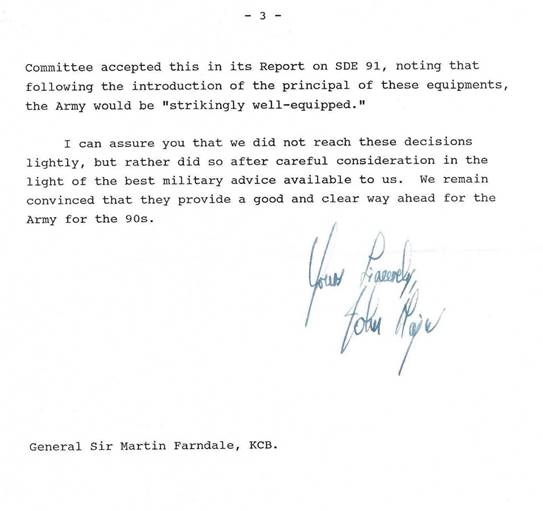
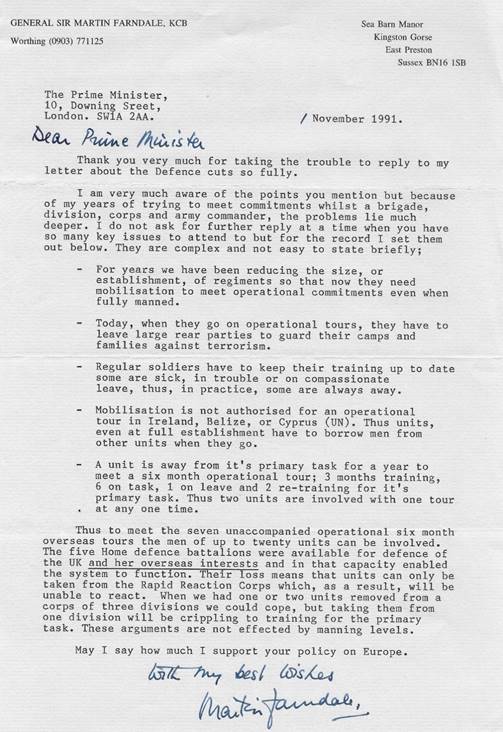
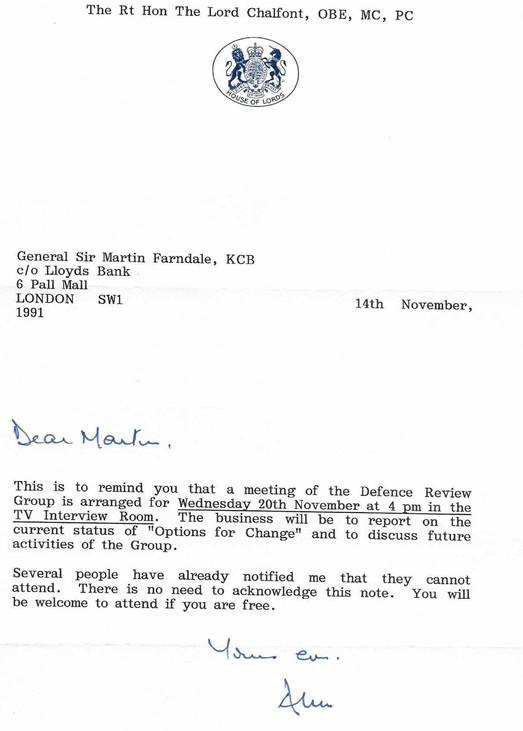
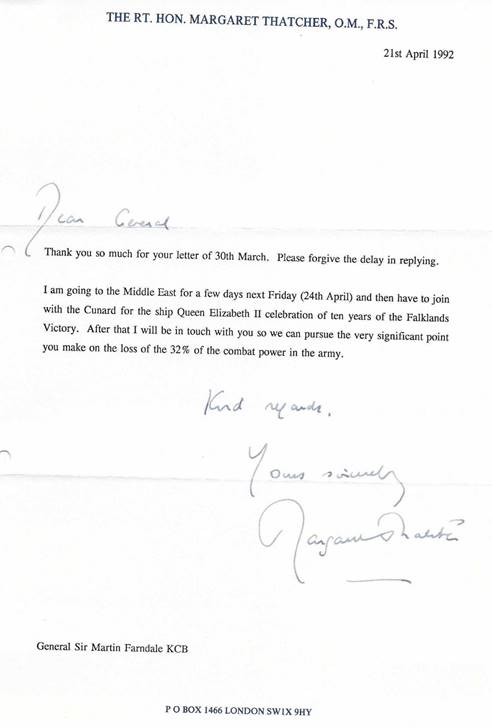
History of the Royal Artillery
From 1989 until his death, he worked tirelessly to create a
museum of artillery at the Royal Arsenal, Woolwich. This was known as the Royal
Artillery Museum Project and became Royal Artillery Museums Limited, of which
he was Chairman. The museum opened a year after his death in May 2001 and is
known as Firepower. It houses the vast regimental collection of guns, medals, books and archives and is also an interactive museum of the
history of artillery. The principal building of the museum is now known as the Farndale
Building and a plaque at the entrance is dedicated to Martin and states
"without his vision, dedication, leadership and commitment, this museum
would not exist."
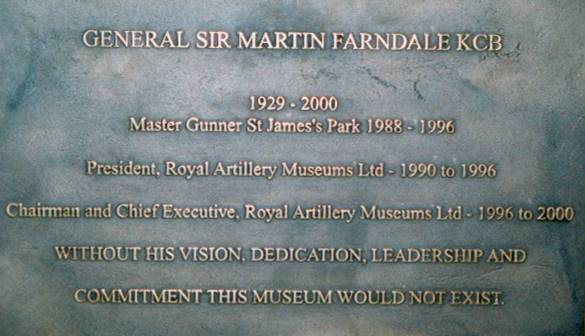

His principal hobby was writing definitive histories of the
Royal Artillery, a task which he started early in his military career and
continued until he died. He wrote the History of the Royal Artillery, France
1914-1918 (published 1987). He wrote the History of the Royal Artillery, The
Forgotten Fronts and the Home Base, 1914-1918
(published 1988). He wrote the History of the Royal Artillery in the Second
World War (The Years of Defeat 1939-41) (published 1996). He wrote the History
of the Royal Artillery (The Far East Theatre 1941-1946) which was published
posthumously. He also wrote many articles for the British Army Review and the
Royal Artillery Journal.
He was also Chairman of the English Heritage Battlefields
Trust from 1993. The trust endeavours to preserve battlefields from being
destroyed by new roads of buildings. Martin succeeded in saving the site of the
Battle of Tewkesbury (1471) from developers.
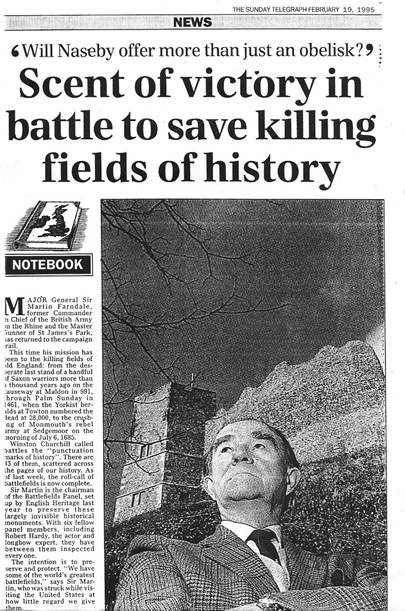
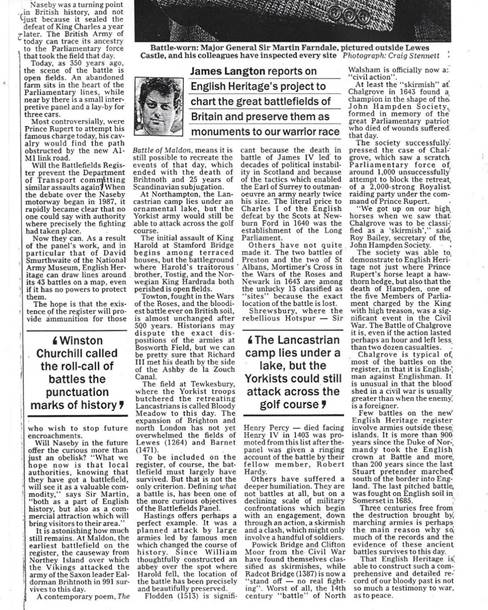
He took part as a guest lecturer during a
number of battlefield tours covering both the First and Second World
Wars.
Royal Artillery Association
He was President of the Worthing Branch of the Royal
Artillery Association from 1988 to 2000. He attended almost every branch
meeting and in 1999, to his great pride, the branch won the Burton Cup for the
best achievement in fundraising towards the museum. The branch unveiled a
plaque to his memory at Gifford House chapel in Worthing in December 2001. The
plaque reads "In Memory of General Sir Martin Farndale 1929-2000,
Commander British Army of the Rhine and Northern Army Group 1985-87, Master Gunner
St James's Park 1988-96, President Worthing Branch The
Royal Artillery Association 1988-2000".
He was also Honorary Colonel of First Regiment Royal Horse
Artillery and of the 3rd Battalion the Yorkshire Volunteers.

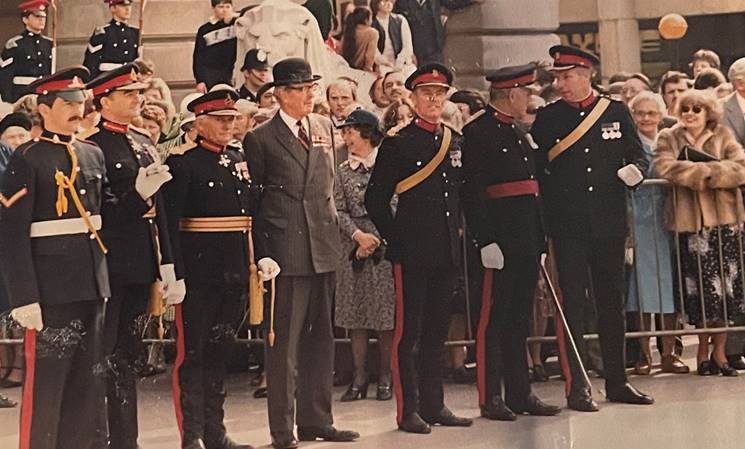
With 1RHA exercising their freedom of Nottingham in
1978
and again in 1982
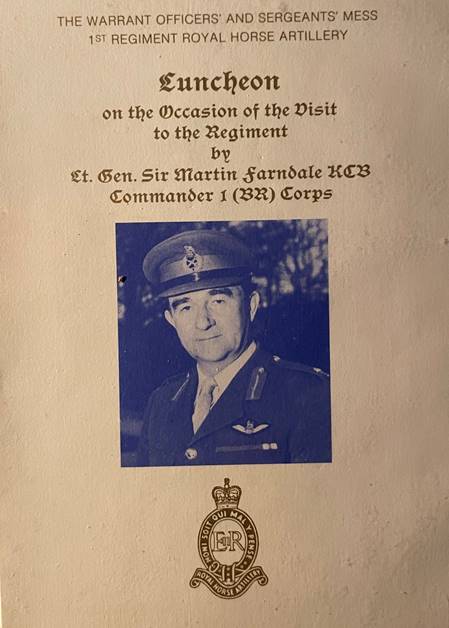
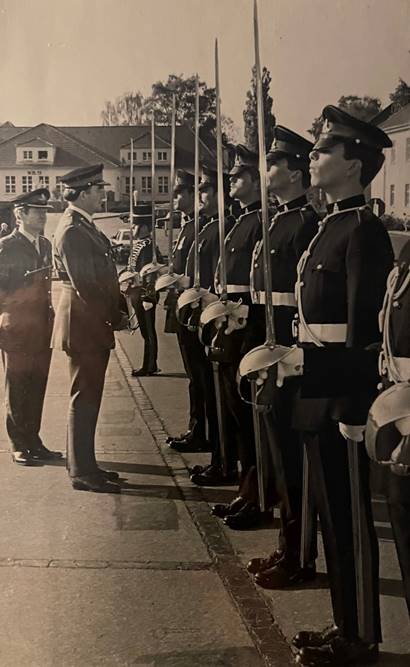
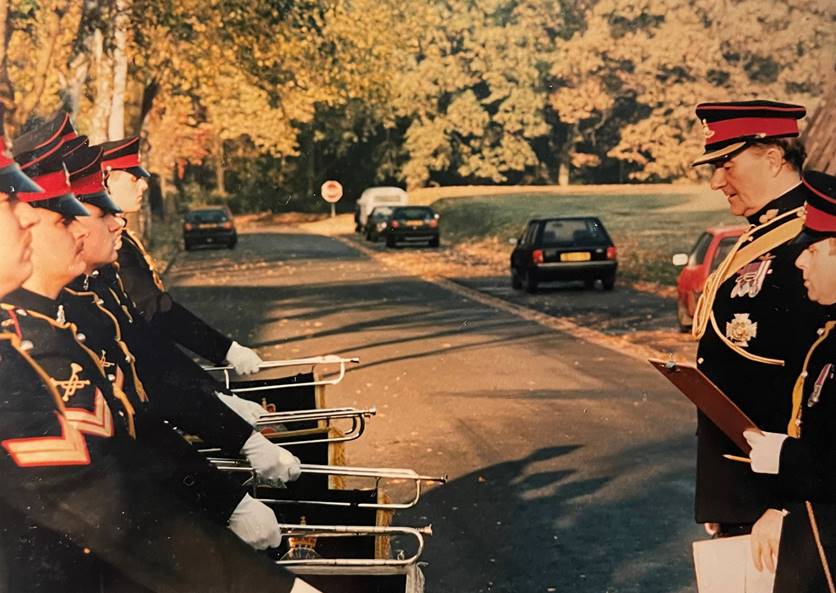
Inspecting B battery in Hohne in 1984
Farewell as Honorary Colonel of 1 RHA in 1989, Hohne, West Germany
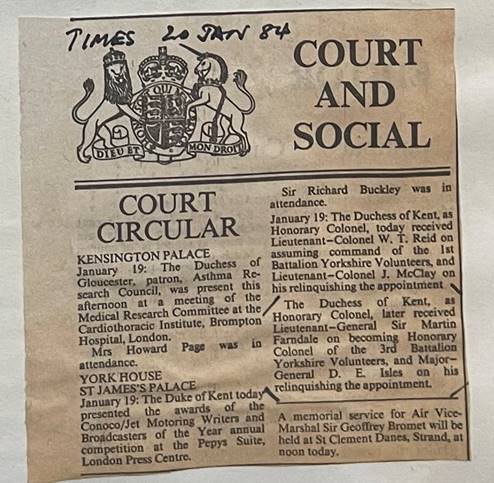
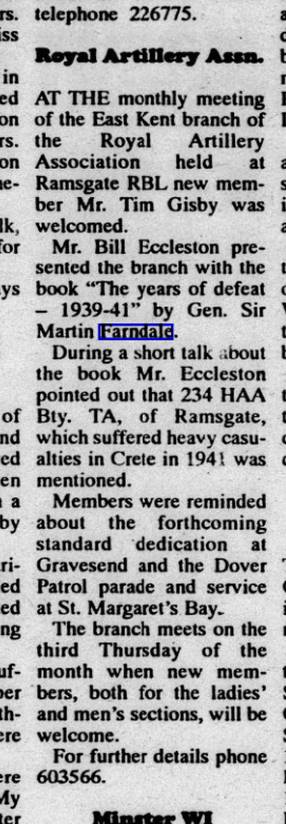
(Isle of Thanet Gazette, 30 May 1997)
Civilian Appointments
He became a Director of Short Brothers plc, Defence Adviser
to Westland Helicopters and to Deloitte & Touche in the City. He was also a
very active chairman of the Royal United Services Institute from 1989-1993. He
became a Freeman of the City of London and a member of the Wheelwrights Livery.
He was awarded an Honorary Degree of Doctor of Letters at
the University of Greenwich for his work on the history of the Royal Artillery.
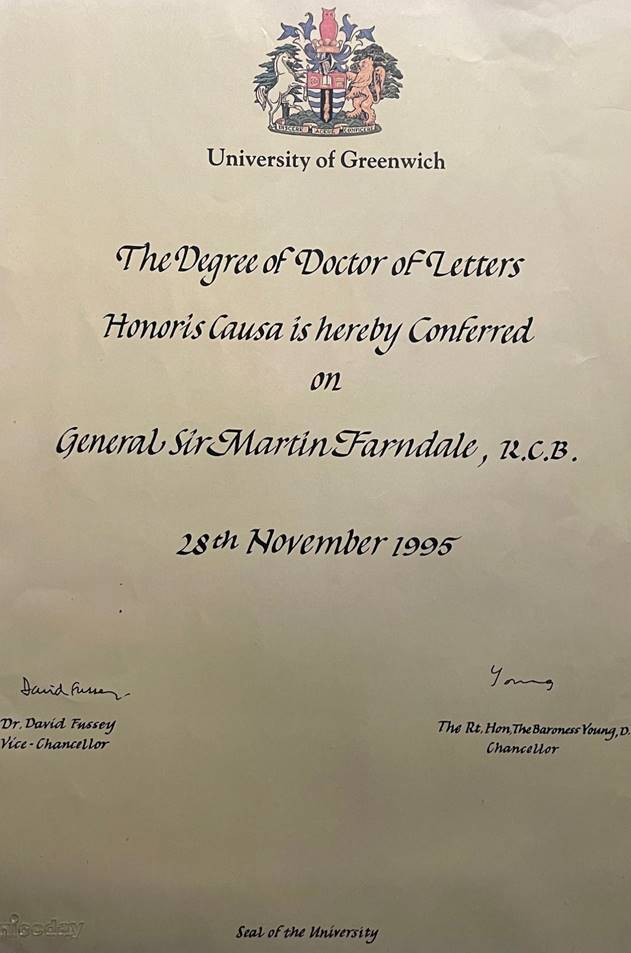
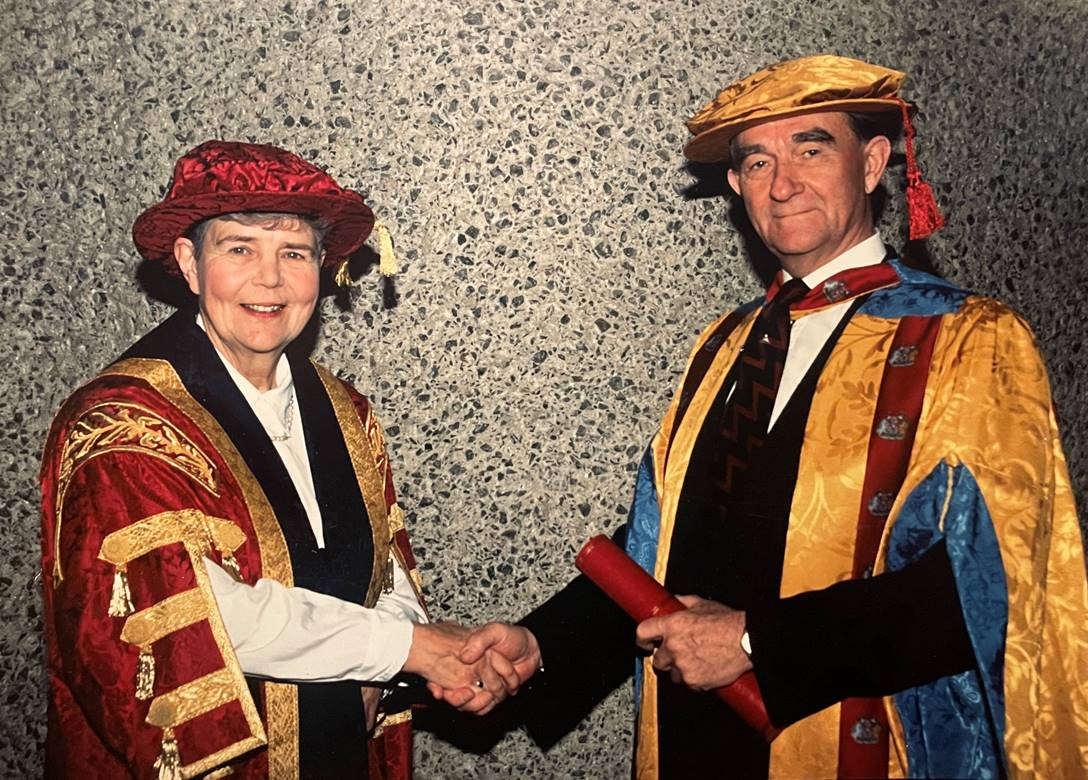
Medals and Honours
He was appointed Companion of the Most Honourable Order of
the Bath in 1980 and Knight Commander of the Order of the Bath in 1983.
His coat of
arms is displayed below.
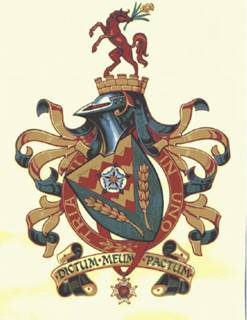
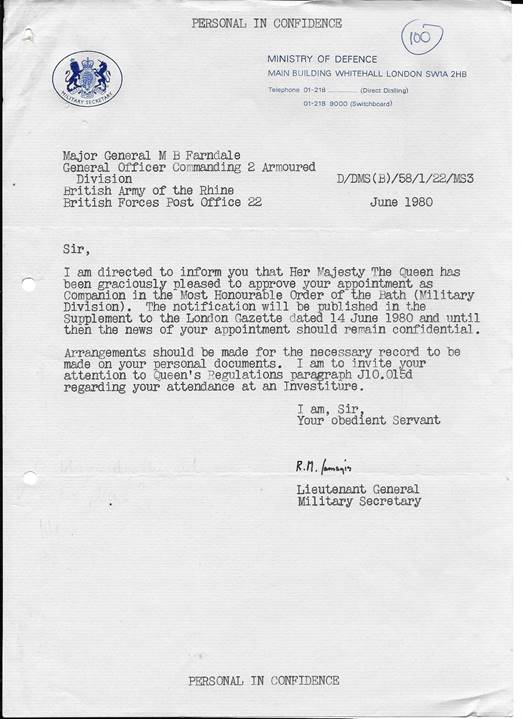
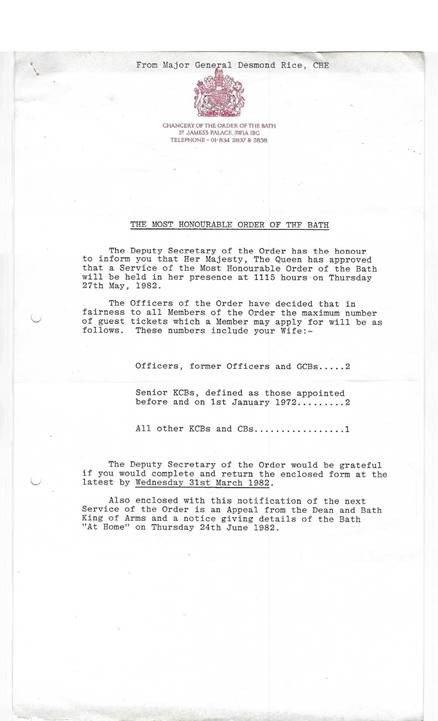
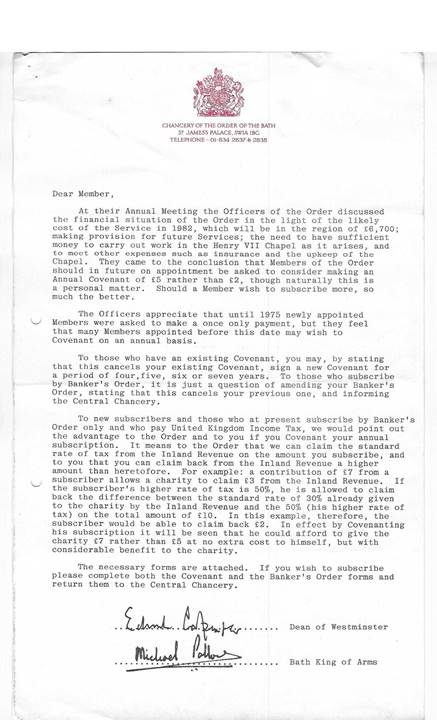
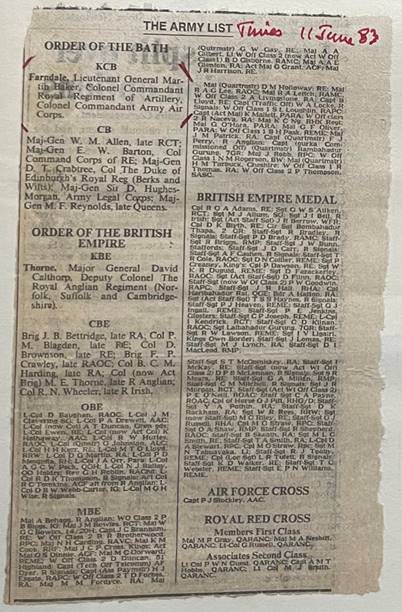

(Daily Post: The Paper for Wales, 11 June 1983)
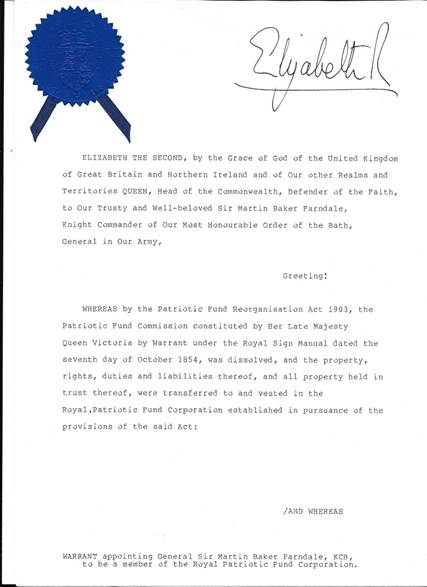
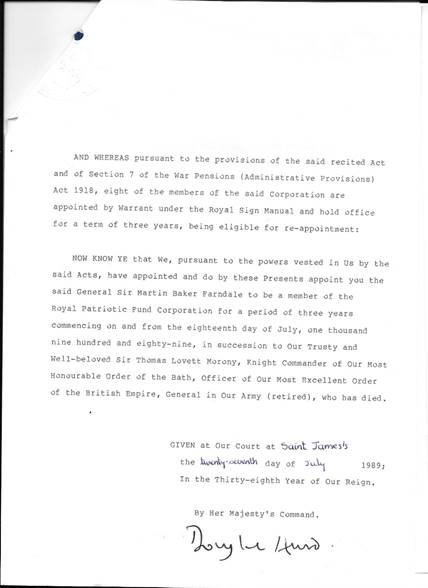
Biography entries in Who’s Who and Debrett’s People of
Today:
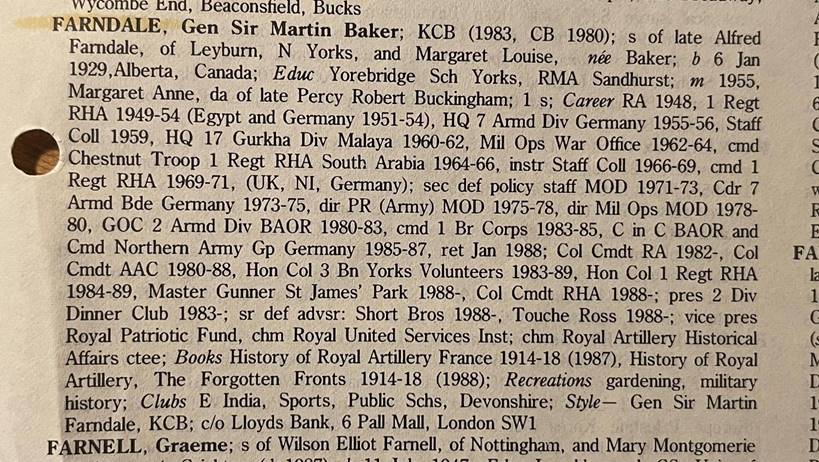
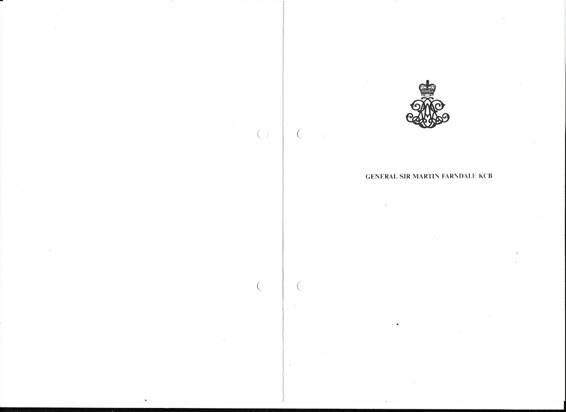
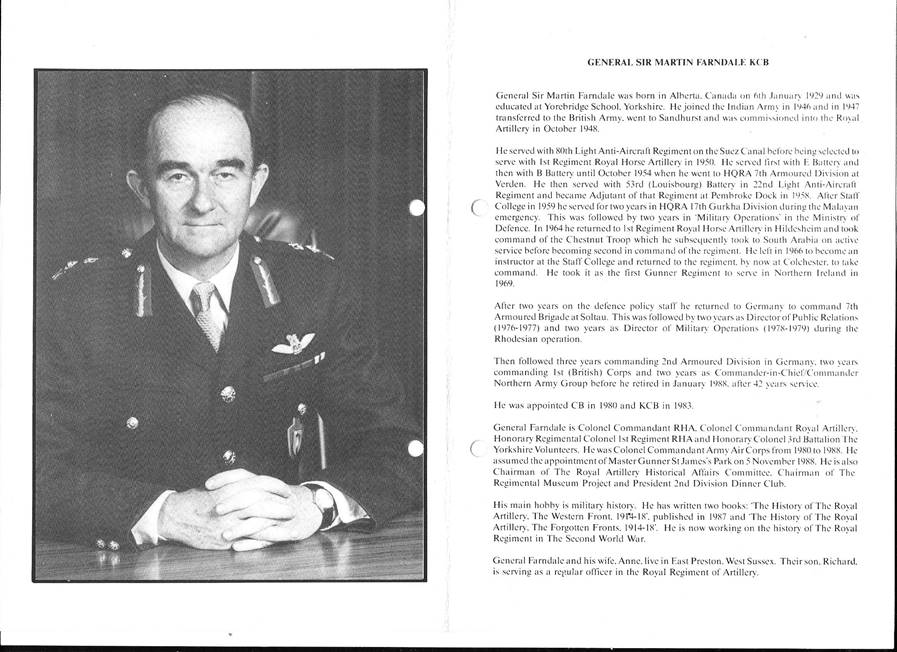
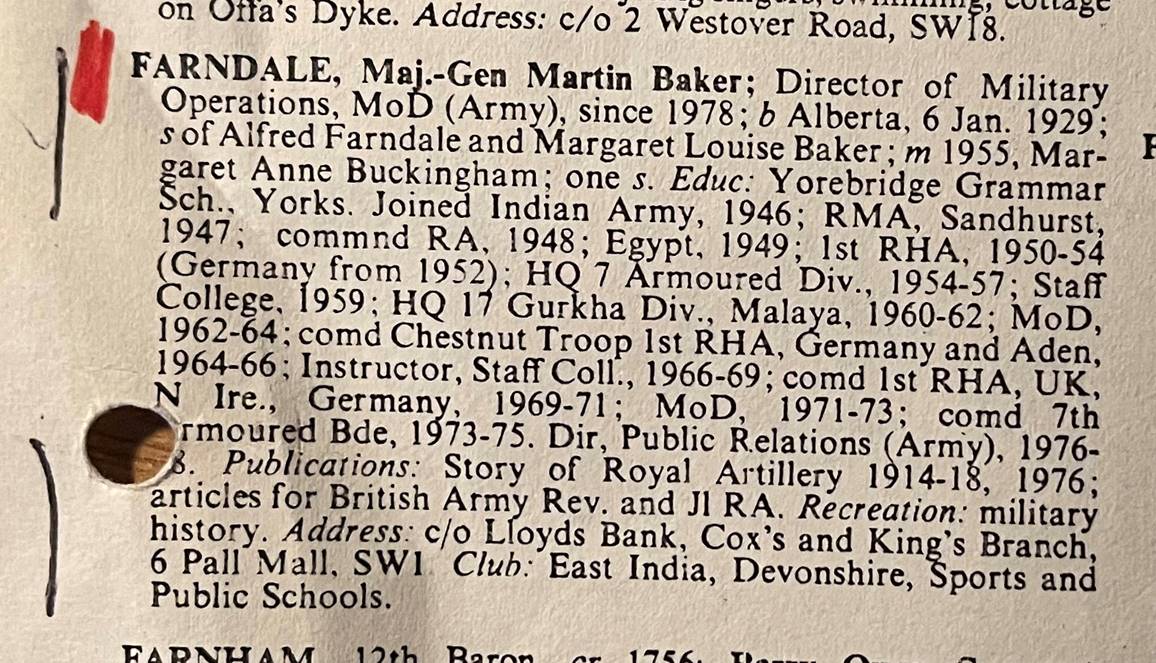
Who’s Who 1978
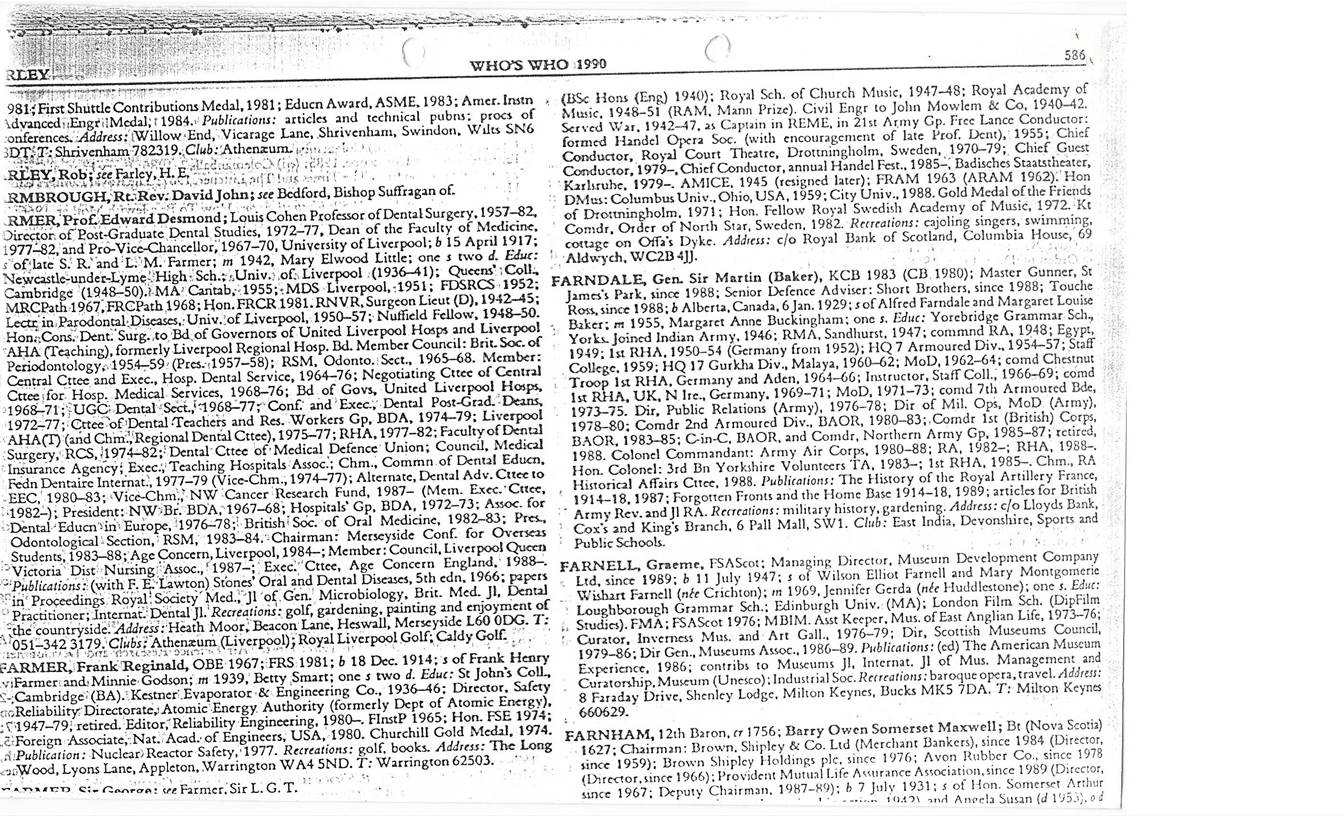
Who’s Who 1990
Other interests
He was a member of the East India and Sports Club from June
1962.
He was also passionately interested in the Farndale family history and the information contained on this website is
almost entirely the result of his work.
He was a very keen and successful gardener which perhaps
kept him close to his farming roots, with his hands firmly in the soil.
2000
Died
Martin Baker Farndale died at the age of 71 at Cromwell
Hospital, London on 10 May 2000. He was cremated at Worthing Crematorium and is
buried at Wensley Church, Wensleydale, North Yorkshire beside his parents. A
Memorial Service was held at St Martin-in-the-fields in London on 26 September
2000.
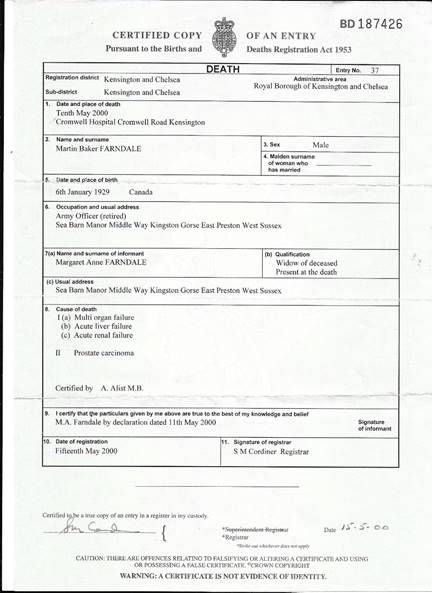
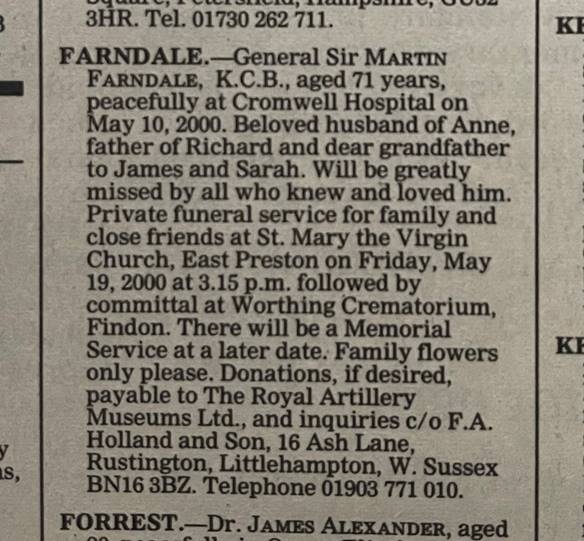
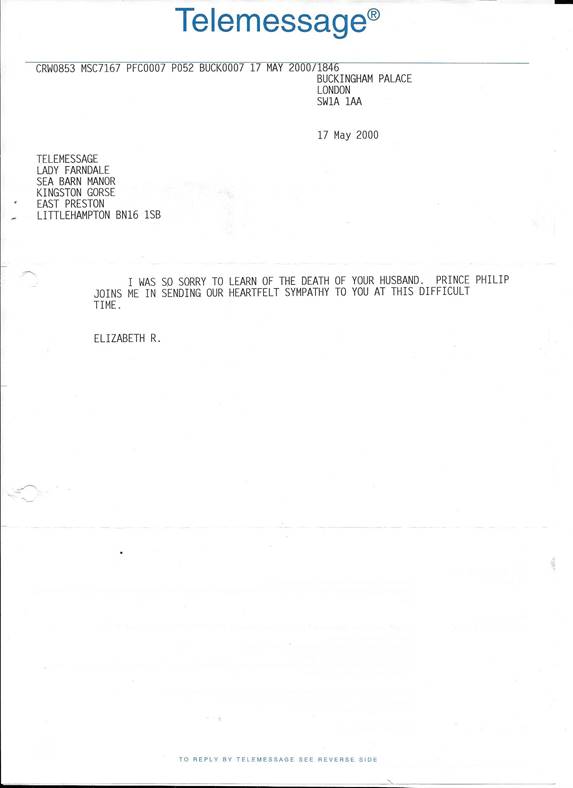
A memorial service was held at St Martin in the Fields in
London
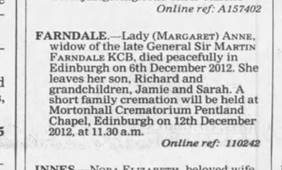
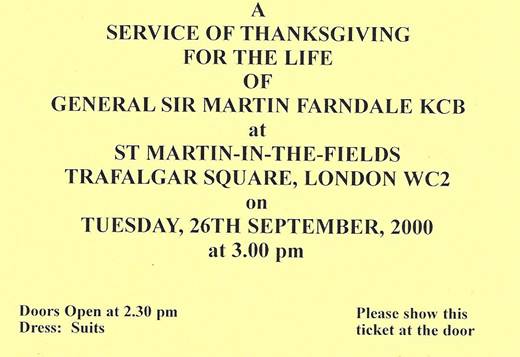



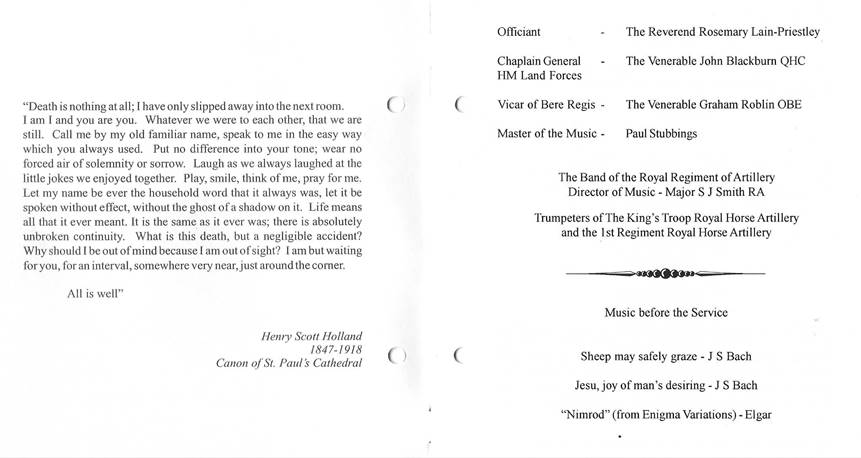
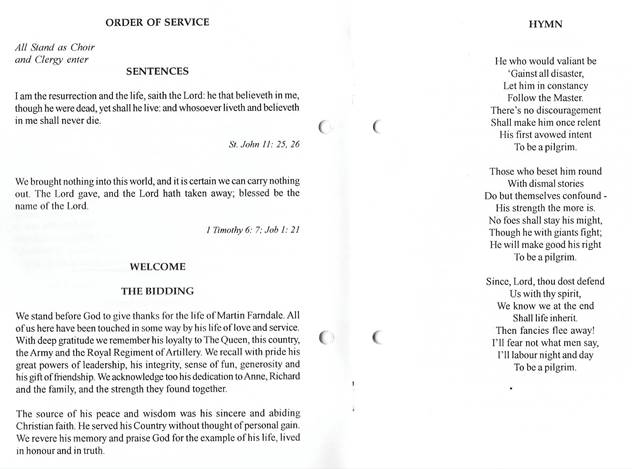
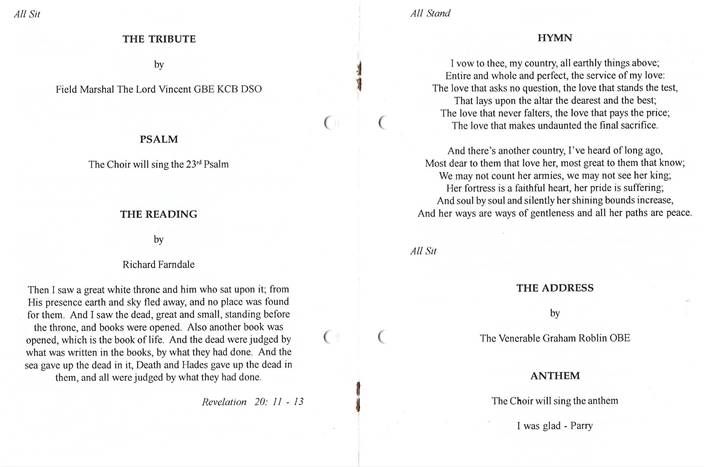
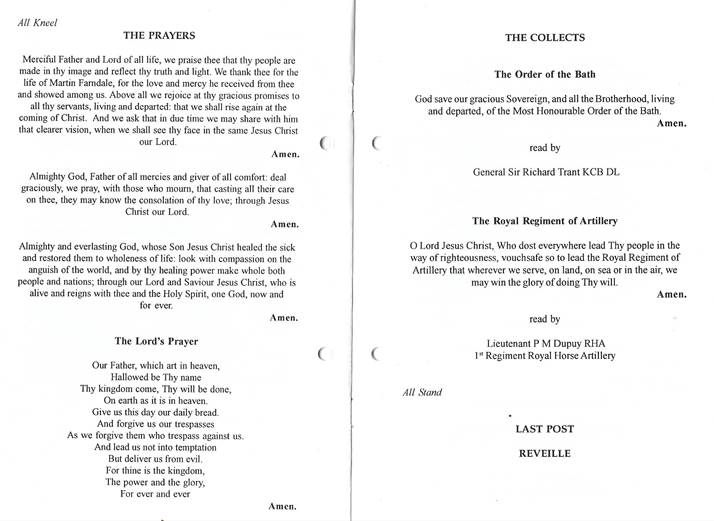


Obituaries
The Guardian, Wednesday 17 May
2000:
John Learmont
Innovative army commander whose leadership qualities took
him to Malaya, Northern Ireland and NATO.
General Sir Martin Farndale, who has died aged 71, was
unquestionably the most distinguished gunner officer of his generation. He had
an outstanding career both in command and on the staff, but
was never more at home than when among soldiers in the field. He was an example
of what can be achieved with a combination of leadership, intellect,
personality, charm and dedication.
He was born in Alberta, Canada, and educated at Yorebridge
school, Yorkshire. He joined the Indian army in 1946 and, in 1947, transferred
to the British army, went to Sandhurst and was
commissioned into the Royal Artillery in October 1948.
He served in several gunner regiments, but his heart lay
with the 1st Regiment, Royal Horse Artillery, with whom he served on and off
for 21 years. He saw service in the UK, Aden and the
British Army of the Rhine and, in 1964, took command of the Chestnut troop, the
senior battery.
In 1969, to his immense pride, Farndale assumed command of
the regiment and, during this period, took it to Northern Ireland, the first
gunner regiment to serve there in an infantry role. Later, he became the first
honorary colonel of the regiment. His infectious enthusiasm, his encouragement
to those who needed a helping hand, his sense of humour and his oratory skills
made him a legend within the regiment in his lifetime.
Farndale would, I feel sure, see himself first and foremost
as a commander. He was at ease with soldiers and they, in turn, followed him
without hesitation. Nevertheless, he was an equally brilliant staff officer.
After passing out from the Camberley staff college in 1959, he served for two
years in HQRA 17th Gurkha Division, where he saw active service during the
final phases of the Malayan campaign, followed by a spell in military
operations at the Ministry of Defence. He became an instructor at Camberley in
1966.
After two years on the defence policy staff, he returned to
Germany to command 7th Armoured Brigade at Soltau. This was followed by two
years as director, public relations, at the MoD, and a further two years as
director of military operations. He then commanded the 2nd Armoured Division in
Germany for three years.
Farndale's grasp of the complexities of the all-arms battle,
allied to his inspirational leadership qualities, led to his being appointed to
command the 1st (British) Corps. Life was always exciting for those serving
with him during this period, as he was a constant source of innovative ideas
that kept all concerned on their toes. His success led to promotion to
commander, Northern Army Group, and commander-in-chief, British Army of the
Rhine.
As a NATO general, Farndale earned the respect and loyalty
of the national corps under his command from Germany, Holland
and Belgium, as well as the 1st British Corps. This was fully tested on
Exercise Certain Strike in 1987, the largest exercise of its type in Europe
since the second world war. Here, Farndale took under his command a fifth
corps, 3 (US) Corps, and established a rapport with its commanding general that
lasted the rest of his life.
In 1980, he was appointed colonel commandant, Army Air
Corps, continuing a line of distinguished senior officers who had filled the
post. This was a new area, and, some might have felt, an added burden to his
already full and demanding military life.
But it was typical of Farndale that, without hesitation, he
committed himself completely to his new role. He took a personal interest in
every aspect of this small but rapidly developing corps, unstinting with his
time and applying his huge capacity for work in an entirely selfless fashion.
There is no doubt that the Army Air Corps flourished under his hand.
He retired in January 1988 after 42 years' service, and became a director and senior defence adviser to
Short Brothers plc, and defence adviser to Deloitte Touche. He kept his links
with the army, and particularly the Royal Regiment of Artillery, when he
assumed the appointment of master gunner, St James's Park, on November 5 1988. During this period, he was also colonel commandant,
Royal Horse Artillery, colonel commandant, Royal Artillery, honorary regimental
colonel, 1st Regiment, Royal Horse Artillery, and honorary colonel, 3rd
Battalion, the Yorkshire Volunteers.
Farndale was also a man of letters and a military historian
of note. He wrote four books covering the history of the Royal Artillery, an
undertaking he was still engaged in at the time of his death. He was chairman
of the English Heritage Battlefields Panel and, from 1989-1993, chairman of the
Royal United Services Institute for Defence Studies.
In his last years, Farndale threw his energies into
safeguarding the heritage of the Royal Regiment of Artillery, particularly as
president, and subsequently chairman and chief executive, of its regimental
museum project at Woolwich. He was an inveterate and persuasive fund- raiser,
to such an extent that some were said to be suffering from donor fatigue.
Thanks to his drive, vision and determination to
overcome manifold obstacles, the museum will open to the public next year.
Martin Farndale was an exceptional man, who lived an
exceptional life. He was generous of spirit, an inspiring leader, a true
comrade in arms and a firm friend. The world is poorer for his passing but his achievements will be remembered for many a
year to come.
He was appointed CB in 1980 and KCB in 1983. He married Anne
Buckingham in 1955; she survives him, with their son Richard. It was a source
of great pride to Farndale that Richard too served in 1st Regiment, Royal Horse
Artillery, his old regiment, to which he remained intensely loyal.
Martin Baker Farndale, soldier, born January 6 1929; died May 10 2000.
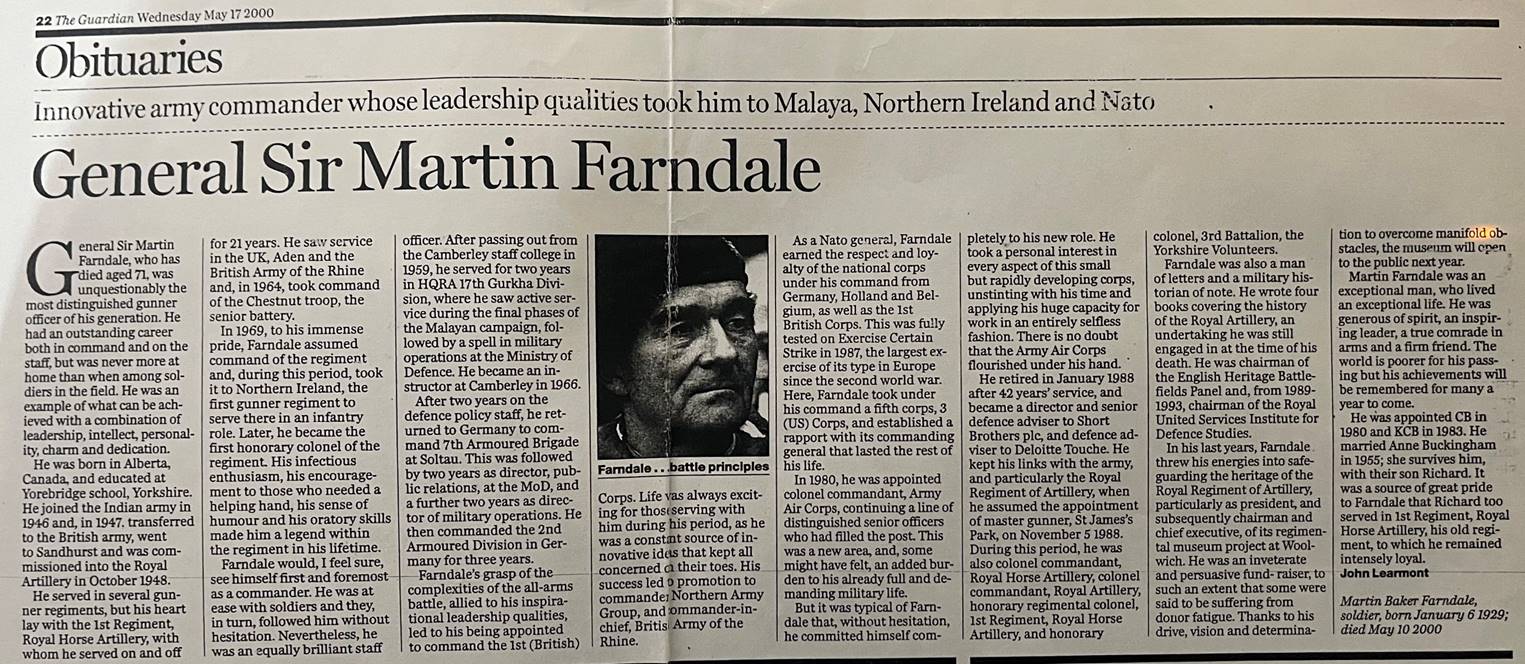
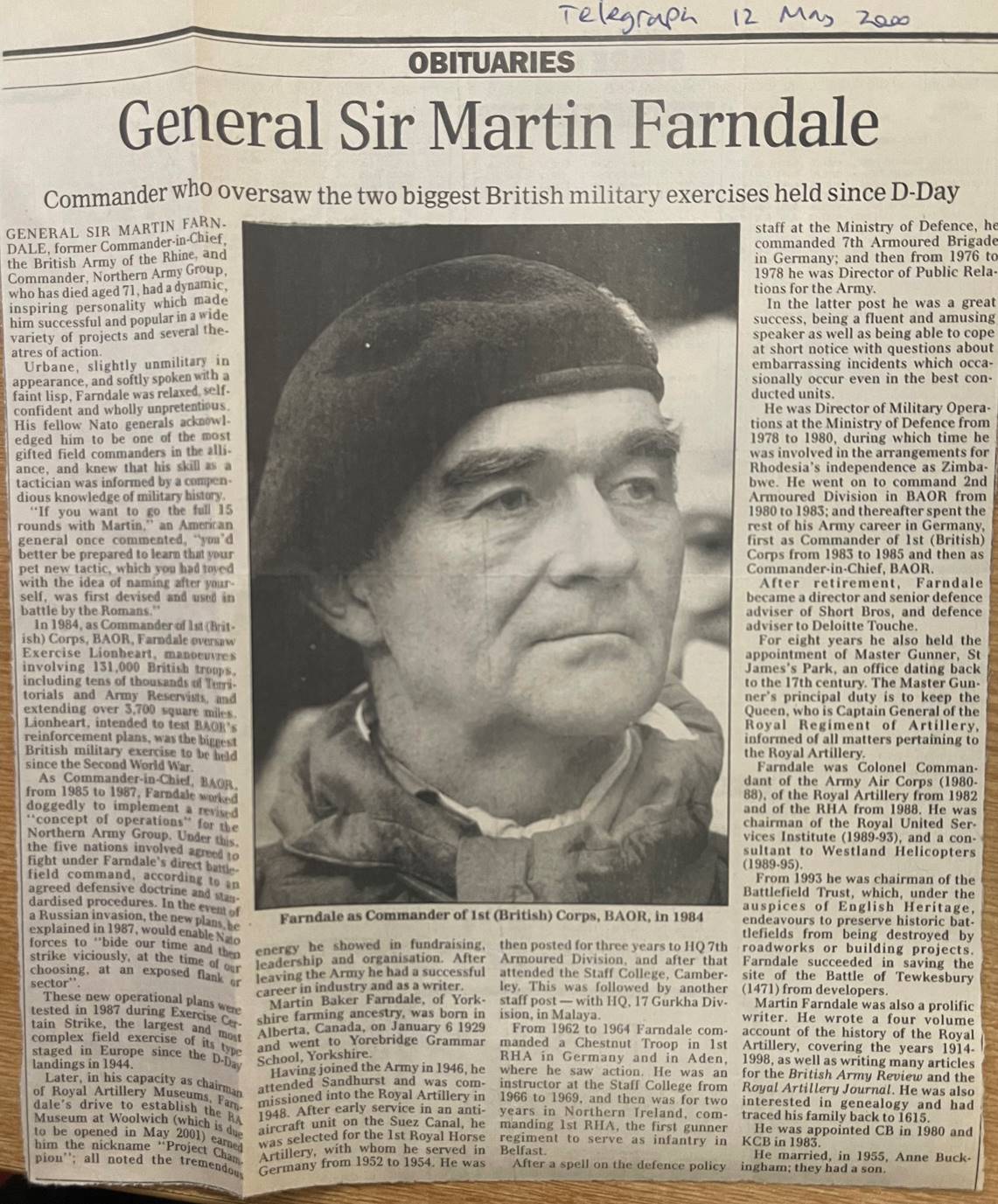
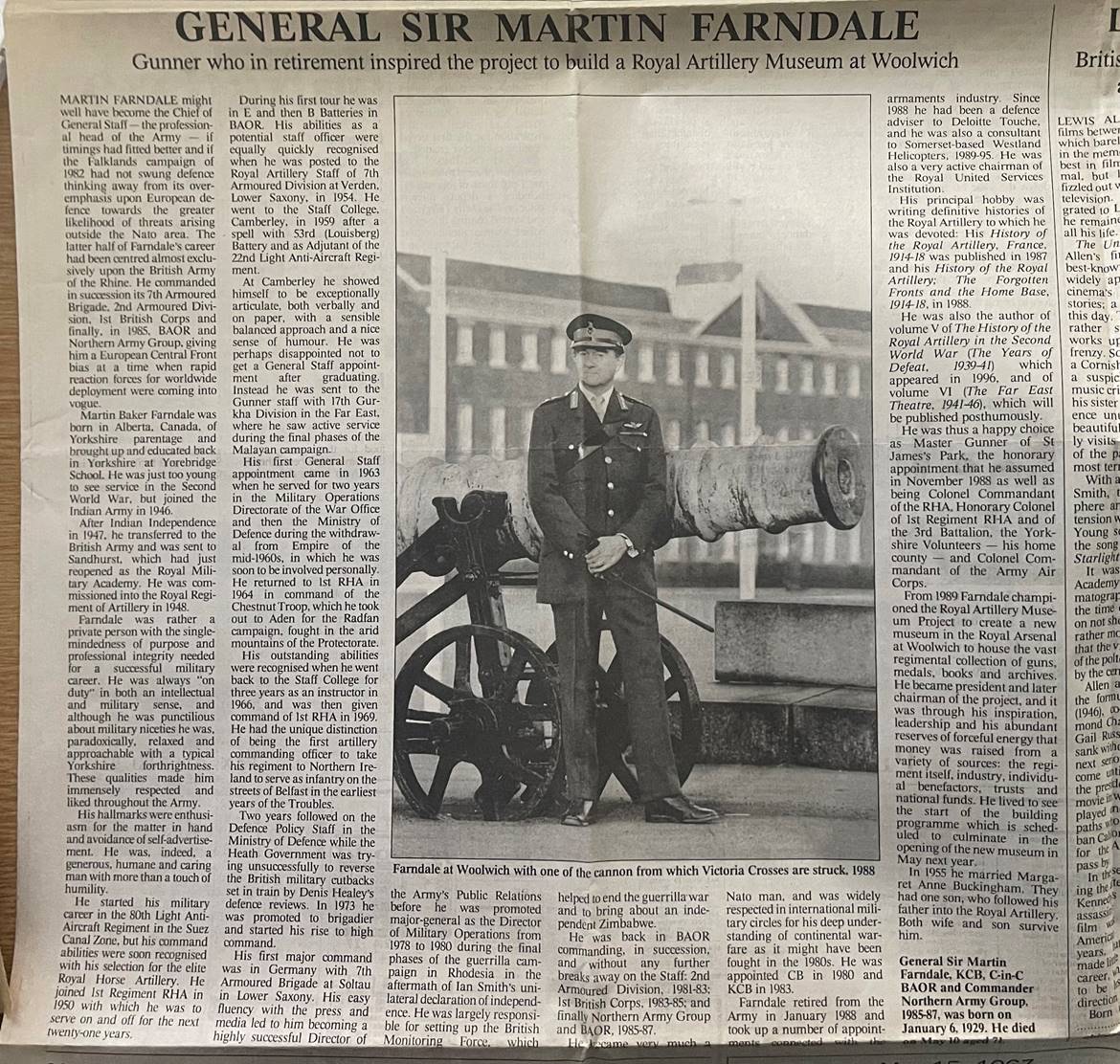
MARTIN FARNDALE was one of the most outstanding generals of
the post-war British army. Confident and dynamic, he was regarded by NATO as
one of its finest field commanders.
As Commander 1st (British) Corps, British Army of the Rhine,
in 1984, Farndale successfully oversaw Operation Lionheart. It was a vast
exercise which involved 131,000 British troops including thousands of Army
Reservists and Territorials. His success led him to being appointed a year
later, Commander-in-Chief BAOR. He earned the respect of the National Corps
under his command and worked tenaciously to bring about a defence policy to
counter any Russian invasion. This policy was fully tested on Exercise Certain
Strike, the largest postwar exercise carried out in Europe.
Martin Farndale was born in 1929 in Alberta, Canada, of
British parents and brought up in Yorkshire. He joined the Indian Army in 1946,
transferring to the British army a year later. After Sandhurst he was
comissioned into the Royal Regiment of Artillery in 1948. He saw service in the
volatile Suez Canal zone where his command qualities were soon recognised. He
was selected for the Royal Horse Artillery (RHA) and attended Staff College,
Camberley, in 1959 before enjoying a staff post with HQ, 17 Gurkha Division
towards the end of the conflict in Malaya.
From 1964 to 1966 he commanded Chestnut Troop in 1st RHA in
Germany and Aden during a particularly difficult period. In 1969, after three
years as a Staff instructor at Camberley, he was given command of 1st RHA in
Northern Ireland, where his gunners were used as infantry during the mounting
civil unrest in Belfast.
After two quieter years at the Ministry of Defence, where he
worked on defence policy, he was given command of 7th Armoured Brigade in
Germany in 1976. His natural enthusiasm and charm helped him become a highly
successful Director of Public Relations for the Army before becoming Director
of Military Operations at the MoD in 1978. This post called for all his
diplomatic skills as he was involved in the arrangements for Rhodesia's
independence as Zimbabwe.
In 1980 he commanded 2nd Armoured Division in Germany where
he was to serve for the remainder of his time in the Army. In 1983 he became
Commander 1st (British) Corps and from 1985 until his retirement in 1987 he was
Commander-in-Chief, BAOR, and Commander, Northern Army Group. He brought to
this post a vast experience. An astute man, he was much admired by those who
served under him for his single mindedness of purpose coupled with humility and
humour.
On retirement after 42 years of service he became a director
and senior defence adviser to Short Brothers and defence adviser to Deloitte
Touche. He maintained his links with the Army and in particular his old
regiment and was very proud to be appointed Master Gunner, St James's Park in
1988. He was also Colonel Commandant, RHA as well as the Royal Artillery and
Army Air Corps and Honorary Colonel 3rd BattalionYorkshire Volunteers (TA).
In 1989 Farndale began to champion the idea of a Royal Artillery museum at the Royal Arsenal at Woolwich to
house the regiment's in large collection. It was mainly due to his inspired
leadership and fund raising skills both as president
and chairman that the money was raised for the building. He lived long enough
to see it take shape. It will be opened in May 2001.
This exceptional man was also fine writer, producing his
History of the Royal Artillery, published in five volumes from 1986. The sixth
volume, The Far East Theatre 1941- 1946, is to be published posthumously. He
was also a contributor to the British Army Review.
Farndale's only son, Richard, followed his father and joined
the Royal Artillery
MAX ARTHUR

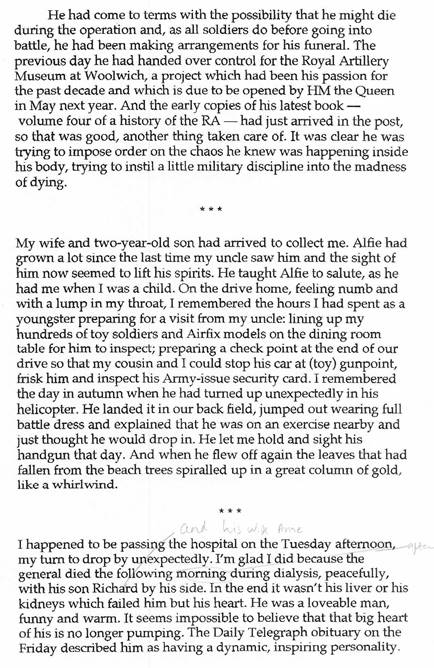
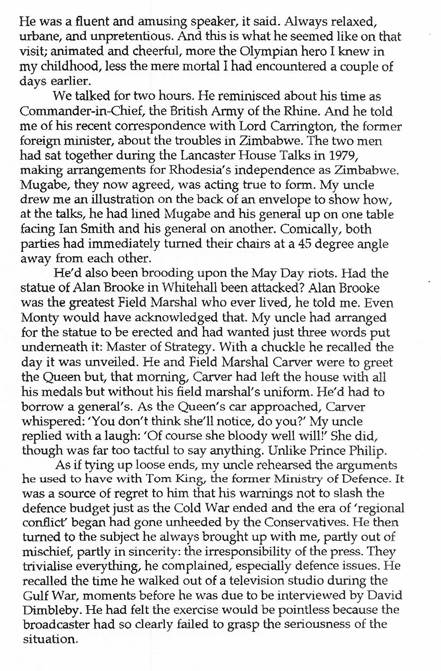

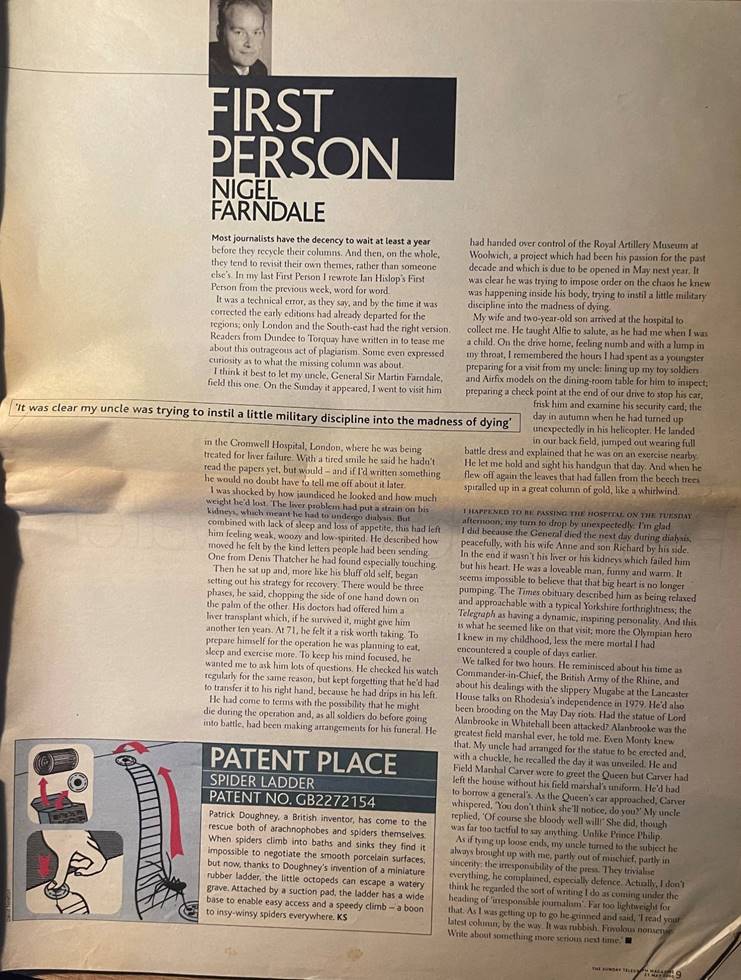
Other recollections of his life
From The Daily Telegraph, 31 July 2005:
You couldn't make it up
By Nigel Farndale (Nephew of Martin Farndale)
… During the first Gulf war my late
uncle, General Sir Martin Farndale, was invited to discuss military strategy
with David Dimbleby.
He accepted, even though he thought
the BBC was being frivolous in its coverage of the war - indulging in endless,
pointless speculation and treating the whole thing as a game and, worse, an
excuse to try out its new computer graphics. I imagine he wanted to convey the
seriousness of the situation, to impress upon viewers the fact that the lives
of British soldiers, including that of his own son, were at risk.
He was shown to a chair, had a
microphone attached to his lapel and was accosted by a make-up artist with a
brush covered in orange powder. This didn't go down well. My uncle ripped off
his microphone and stormed out the studio, muttering darkly to himself. In one
gesture, it seemed, that poor make-up artist had epitomised all that my uncle
felt was rotten and decadent about the BBC in particular and
modern society in general.
Perhaps things have changed since my
uncle's day, although when I look at General Sir Mike Jackson, he of the face
and voice of thunder, I find this hard to believe. While it is true that
Jackson had surgery to reduce the bags under his eyes, this was done for
medical reasons - they were affecting his eyesight - and woe betide the
journalist who suggests otherwise.
Unlike prime ministers, generals cannot afford to appear effete.
They are and must be bastions of masculinity, not least because they have to command the respect of their men. And not only do
they have to make tough decisions but they also have
to witness the consequences of them, unsentimentally.
I suspect that a dusting of orange powder would have been to my
uncle what the cutting off of hair was to Sampson, a
sapping of his strength, albeit it mental rather than physical. …

